 |
[ Outlaw Genealogy | Bruce
History | Lost Chords ] [ Projects | News | FAQ | Suggestions | Search | HotLinks | Resources | Ufo ] |
 |
[ Outlaw Genealogy | Bruce
History | Lost Chords ] [ Projects | News | FAQ | Suggestions | Search | HotLinks | Resources | Ufo ] |
Some new information to post ( using new publication tools hmm lets see... )
Here we have a pair of War of Roses warriors : John Outlawe a Norfolk Archer
and Richard Outlaw a Naval Gentleman Man-at-Arms
Interesting ties to
Ireland as well with John Outlawe's connection to Richard of York
1437 -
John Outlawe
- 03/23/1437
- Archer
- Les Andelys - Captain Thomas Picot - John Talbot Earl Shrewsbury - BNF, MS. Fr. 25773, no. 1175
1441 -
John Outlawe
- 1441
- Archer
- Expedition France - Richard Duke of York - Richard Duke of York - TNA, E101/53/33, m3
1445 -
John Outlawe
- 06/15/1445
- Archer
- Retinue Kings Councillor - Sir William Oldhall - TNA, E101/53/33, m3
http://www.medievalsoldier.org/database/maindbsearch.php ( search Owtlawe )
Outlawe, John 03/23/1437 - 1441 - 06/15/1445
Outlawe, Richard 09/14/1442
| Name | Origin | Status | Rank | Service | Captain | Lieutenant / Sub-Captain | Commander | Service Date | Source Type | Reference |
|---|---|---|---|---|---|---|---|---|---|---|
| Outlawe, John | Archer | Detachment, garrison of Regneville, Vexin; mustered: Les Andelys | Picot, Thomas | Talbot, John (1385 - 1453) earl of Shrewsbury | 14370323 | Muster Roll | BNF, MS. Fr. 25773, no. 1175 | |||
| Outlawe, John | Archer | Expedition, France | York, Richard of (1411 - 1460) duke of York | York, Richard of (1411 - 1460) duke of York | 1441 | Retinue roll | TNA, E101/53/33, m3 | |||
| Outlawe, John | Archer | Official Retinue, king`s councillor | Oldhall, William, Sir (c. 1390 - 1460) | 14450615 | Muster Roll | BL, Add. MS. 21411, f. 30 |
| Outlaw, Richard | Man-at-Arms | Naval Service | Stapleton, Miles | 14420914 | Muster Roll | TNA, E101/54/3, no2_m1 |
What is very interesting about this is that John Outlawe became
part of the royal court of Richard Duke of York .
"Official Retinue, king`s councillor"
Richard was in direct line to be King.
https://en.wikipedia.org/wiki/William_Oldhall
Sir William
Oldhall (1390?–1460) was an English soldier and
Yorkist supporter, who served as
Speaker of the
House of Commons of England between 1450-51
The son and heir of Sir Edmund Oldhall of Narford, Bodney, and East Dereham, Norfolk, by Alice, daughter of Geoffrey de Fransham of the same county, he was born about 1390. As an esquire in the retinue of Thomas Beaufort, 1st Earl of Dorset, he was present at the siege of Rouen in 1418–19. He also served under Thomas Montacute, 4th Earl of Salisbury in the expedition for the relief of Crevant, July 1423, and won his spurs at the battle of Verneuil on 17 August 1424. About this date he was made seneschal of Normandy. In the subsequent invasion of Maine and Anjou he further distinguished himself, and was appointed constable of Montsoreau and governor of St. Laurent des Mortiers.[2]
In the summer of 1426 Oldhall was employed in Flanders on a mission to Philip the Good, Duke of Burgundy concerning Jacqueline, Duchess of Gloucester, then a prisoner in the duke's hands. In October 1428 he was detached by the council of Normandy to strengthen the garrison of Argentan, then in danger of falling by treachery into the hands of Jean II, Duke of Alençon. He was present at the great council held at Westminster, 24 April–8 May 1434, on the conduct of the war in France, and also at the council of 24 February 1438–9. In 1440 he was chamberlain to Richard of York, 3rd Duke of York, and a member of his council, and the following year was made feoffee to his use and that of his duchess Cecilia of certain royal manors. In the struggle for the retention of Normandy he commanded the castle of La Ferté Bernard, which fell into the hands of the French on 16 August 1449.[2]
Oldhall was with the Duke of York in Wales in September 1450; was returned to parliament for Hertfordshire on 15 October of the same year, and on 9 November following was chosen Speaker of the House of Commons. Indicted in 1452 for complicity in the insurrection of Jack Cade and the subsequent rebellion of the Duke of York, he was found guilty, outlawed, and attainted on 22 June. He took sanctuary in the chapel royal of St. Martins-le-Grand, where he remained in custody of the king's valet until after the First Battle of St Albans on 22 May 1455, but obtained his release and the reversal of his outlawry and attainder on 9 July. He was again attainted in November 1459 as a fautor and abettor of the recent Yorkist insurrection; but on the accession of Edward IV of England the attainder was treated as null and void.[2] He died in London in November 1460, and was buried in St Michael Paternoster Royal.[3]
Besides his Norfolk estates Oldhall held (by purchase) the manors of Eastwich and Hunsdon, Hertfordshire. On the latter estate he built, at the cost of seven thousand marks, a castellated brick mansion. It remained in the Crown, notwithstanding the avoidance of his second attainder, and was converted by Henry VIII into a royal residence. In 1558 it was granted by Elizabeth I to Sir Henry Cary. It was later transformed into the existing Hunsdon House.[2]
https://en.wikipedia.org/wiki/Richard_of_York,_3rd_Duke_of_York
Richard of York, 3rd Duke of York KG (21 September 1411 – 30 December 1460), was a leading English magnate, a great-grandson of King Edward III through his father, and a great-great-grandson of the same king through his mother. He inherited vast estates and served in various offices of state in Ireland, France, and England, a country he ultimately governed as Lord Protector during the madness of King Henry VI. His conflicts with Henry's wife, Margaret of Anjou, and other members of Henry's court, as well as his competing claim on the throne, were a leading factor in the political upheaval of mid-fifteenth-century England, and a major cause of the Wars of the Roses. Richard eventually attempted to take the throne, but was dissuaded, although it was agreed that he would become king on Henry's death. But within a few weeks of securing this agreement, he died in battle.
Although Richard never became king himself, he was the father of King Edward IV and King Richard III.
York returned to England on 20 October 1445 at the end of his five-year appointment in France. He must have had reasonable expectations of reappointment. However, he had become associated with the English in Normandy who were opposed to the policy of Henry VI's Council towards France, some of whom had followed him to England (for example Sir William Oldhall and Sir Andrew Ogard). Eventually (in December 1446) the lieutenancy went to Edmund Beaufort, 2nd Duke of Somerset, who had succeeded his brother John. During 1446 and 1447, York attended meetings of Henry VI's Council and of Parliament, but most of his time was spent in administration of his estates on the Welsh border.
https://en.wikipedia.org/wiki/John_Talbot,_1st_Earl_of_Shrewsbury
John Talbot, 1st Earl of Shrewsbury and 1st Earl of Waterford KG (1384/1387 – 17 July 1453), known as "Old Talbot", was a noted English military commander during the Hundred Years' War, as well as the only Lancastrian Constable of France.
,_vu_du_ciel.jpg)
Château Gaillard (Les Andelys)
In January 1436, he led a small force including Thomas Kyriell and routed La Hire and Xaintrailles at Ry near Rouen. The following year (1437) at Crotoy, after a daring passage of the Somme, he put a numerous Burgundian force to flight. In December 1439, following a surprise flank attack on their camp, he dispersed the 6000 strong army of the Constable Richemont, and the following year he retook Harfleur. In 1441, he pursued the French army four times over the Seine and Oise rivers in an unavailing attempt to bring it to battle.
Around February 1442, Talbot returned to England to request urgent reinforcements for the Duke of York in Normandy. In March, under king's orders, ships were requisitioned for this purpose with Talbot himself responsible for assembling ships from the Port of London and from Sandwich.[14]
On Whit Sunday, 20 May, Henry VI created him Earl of Shrewsbury. Just five days later, with the requested reinforcements, Talbot returned to France where in June they mustered at Harfleur. During that time, he met his six-old year daughter Eleanor for the first time and almost certainly left the newly created Countess Margaret pregnant with another child.[15]
In June 1443, Talbot again returned to England on behalf of the Duke of York to plead for reinforcements, but this time the English Council refused, instead sending a separate force under Shrewsbury's brother-in-law, Edmund Beaufort. His son, Sir Christopher stayed in England where shortly afterwards he was murdered with a lance at the age of 23 by one of his own men, Griffin Vachan of Treflidian on 10 August at "Cawce, County Salop" (Caus Castle).[
Interesting connections to the Duke of York - Ireland Wales and Clare ...
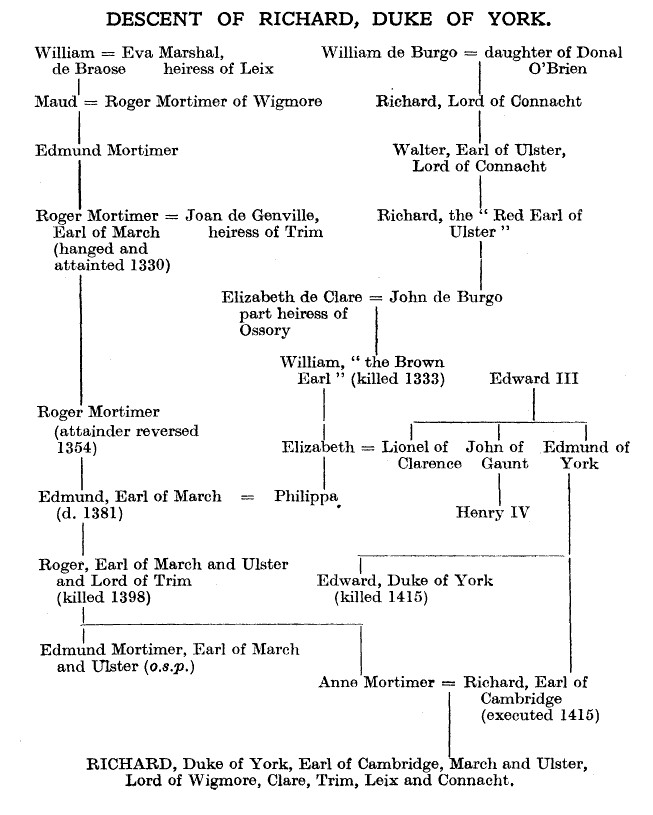
The Soldier in Later Medieval England
| Birth: | 1395 Ingham Norfolk, England |
| Death: | Oct. 1, 1466 Ingham Norfolk, England |
Sir Miles Stapleton, KG (1395 – 1 October 1466) was Lord of the Manor of Ingham, Norfolk and de jure Baron Ingham of Ingham, Norfolk, and Lord of the Manor of Bedale, North Yorkshire. Sir Miles Stapleton was the son of Sir Brian Stapleton, of Ingham (1379 - 1438), Sheriff of Norfolk, a veteran of the Battle of Agincourt, and Cecily Bardolf (d. 1432), daughter to William Bardolf, 4th Baron Bardolf, of Wormegay, Norfolk, and Agnes de Poynings. Sir Miles Stapleton married firstly Elizabeth Felbrigge, daughter of Sir Simon Felbrigge, Knight of the Garter, of Felbrigg, Norfolk by Margaret, perhaps of Teschen, a kinswoman and lady in waiting to English queen Anne of Bohemia. They had no issue. He married secondly in 1438, Katherine de la Pole (1416-1488, buried in Rowley Abbey, Oxfordshire), daughter and heiress to Sir Thomas de la Pole (aft. 1397-1433), who died in France while a hostage for his brother William, son to Michael de la Pole, 2nd Earl of Suffolk. They had two known daughters, the eldest, Elizabeth Stapleton, married before March 1464, Sir William Calthorpe, Knt., of Burnham Thorpe, Norfolk. The younger daughter, Jane (or Joan) Stapleton (d. 1519), married Sir Christopher Harcourt, Knt., of Great Ashby, (Ashby Magna), Leicestershire (d. 1474). He was a Knight of the Shire for Suffolk, and for Norfolk also, and was High Sheriff of Norfolk and Suffolk in 1440. In 1441-2 Sir Miles Stapleton and Thomas Tudenham were summoned as Knights and M.P.'s for Norfolk to attend the Privy Council. Stapleton was in the French wars, where he is said to have single-handedly taken seven prisoners. He had a Royal Commission for the safekeeping of the seas in 1442. The following year he and his brother, Bryan Stapleton of Crispings, in Happisburgh, & Hasilden, Norfolk, received the thanks of the Privy Council in connection with a riot at Norwich. |
|
A man-at-arms was a
soldier from
the
High Medieval to
Renaissance periods who was typically well-versed in the use of arms and
served as a fully armoured
heavy cavalryman.[a]
A man-at-arms could be a
knight or
nobleman, a member of a knight or nobleman's retinue or a
mercenary in a company under a mercenary captain. Such men could serve for
pay or through a
feudal obligation. The terms knight
and man-at-arms are often used
interchangeably, but while all knights equipped for war certainly were
men-at-arms, not all men-at-arms were knights.
...
The social structure of the Anglo-Norman society of England was relatively rigid, however, one of the easiest ways for a man to improve his social rank was through military service; another method was through the church. In the Norman states, unlike in many other contemporary societies, the knighting of men of common birth who had demonstrated ability and courage on the field of battle was possible. Although rare, some non-knightly men-at-arms did advance socially to the status of knights. The knighting of squires and men-at-arms was sometimes done in an ignoble manner, simply to increase the number of knights within an army (such practice was common during the Hundred Years' War). In chivalric theory, any knight could bestow knighthood on another, however, in practice this was usually done by sovereigns and the higher nobility. It is recorded that the great mercenary captain Sir John Hawkwood knighted a number of his followers, as many as twenty on one occasion, though he could reasonably be expected to provide the income his created knights required to maintain their new status.[23] Attempts to restrict the power of commanders to make knights would increase during the 16th century and by the end of Elizabeth I's reign, the practice had all but ceased.[24]
Although a knight bachelor, a knight banneret and all grades of nobility usually served as men-at-arms when called to war, the bulk of men-at-arms from the later 13th century came from an evolving social group which became known as the gentry. The man-at-arms could be a wealthy mercenary of any social origin, but more often he had some level of social rank based on income, usually from land. Some came from the class known as serjeants but increasingly during the 14th century they were drawn from an evolving class of esquire. Esquires were frequently of families of knightly rank, wealthy enough to afford the arms of a knight but who had thus far not been advanced to knightly status or perhaps had avoided it because they did not want the costs and responsibilities of that rank. Also found serving as men-at-arms were the lowest social group of the gentry, known by the 15th century simply as gentlemen.[25]
The proportion of knights among the men-at-arms varied through time. Between the 1280s and 1360s, figures between 20-30% were commonplace. Thereafter, there was a rapid decline, with the figure dropping to 6.5% in 1380. A slight rise is recorded to 8% at Agincourt, perhaps because this was a royal army, but thereafter the figure continued to decline and by 1443, the Duke of Somerset mustered only 1.3% knights among his men-at-arms.[26]
Now the Timothy Outlaw Geneoloy book can be found in an online library:
Ok I finished doing a DNA test and now I need to comfirm other Outlaw have the same type I-P109:
I-P109 is a subgroup of I-M253
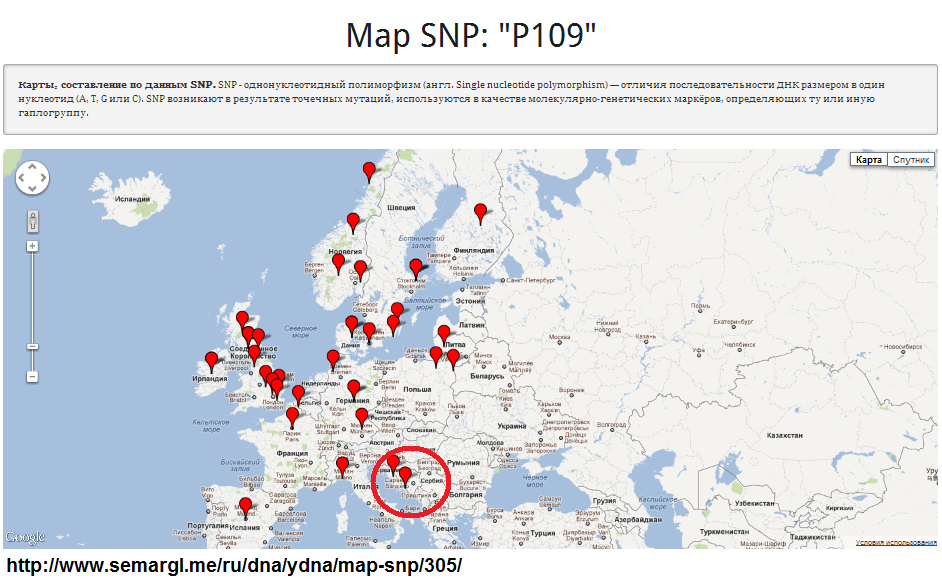
Paternal Haplogroup
Haplogroup I-M253 Migration
Origin: Haplogroup
I-M253 can be found at levels of 10% and higher in many parts of Europe, due to
its expansion with men who migrated
northward after the end of the Ice Age
about 12,000 years ago. It reaches its highest levels in Denmark and the
southern parts of Sweden and
Norway.
As an example another family with i-P109:
http://www.waughfamily.ca/Ancient/#Waugh_Family_DNA
M253 (I1) -P109-S10891-Y13930-Y14225
According to YFull's calculations Haplogroup I-P109 was formed about 4100 years ago and each of the major subbranches (Y14999, Y3664, Y5621, S10891 and Y3662) were formed about 3300 years ago. Therefore, the spread of the P109 marker began between 2000 to 1300 BC or in the Nordic Bronze Age . The TMRCA for S10891 is 3200 years ago, for Y13930 (or FGC21732) it's 2400 years ago and for Y14225 it's 800 years ago (around 1200 AD). Y13930 (FGC21732) is the major division within S10891 that appears to separate the mainly British Isles branch from the Scandinavian (mainly Norwegian & Swedish) branch. If YFull's calculations are correct (and based on the limited sample size) it's possible that Norse settlement in the British Isles began at least as early as 200 BC. Several Bronze Age archaeological sites in the British Isles contain Baltic Amber (and other trade goods) that must have moved (along with traders and possible migrants) across the North Sea by boat.
Our Y-DNA-111 markers (for Jeff Waugh)
indicate that we are M253-L22-P109 (I1a1b1 by ISOGG).
Big-Y DNA results
indicate a new terminal haplogroup of I-S10891 (Nordtvedt May 26, 2014).
Yfull identifies new subclade under IS10891 of I-Y13930 (April, 2015).
Yfull
identifies new subclade under I-Y13930 of I-Y14225 (June, 2015)
FTDNA
identifies FGC21765 under S10891 (Nov, 2015)
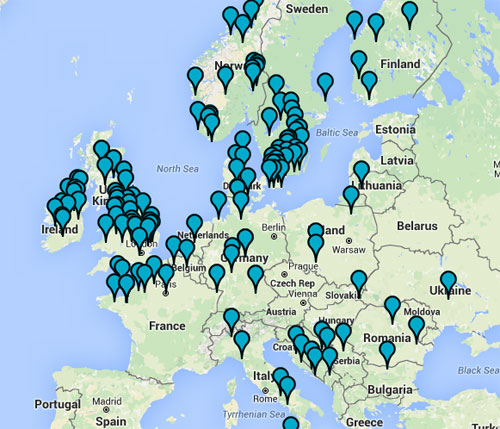
P-109 Distribution in Europe
http://www.waughfamily.ca/Ancient/#The_Nordic_Bronze_Age
"...the spread of the P109 marker began between 2000 to 1300 BC or in the Nordic Bronze Age . "
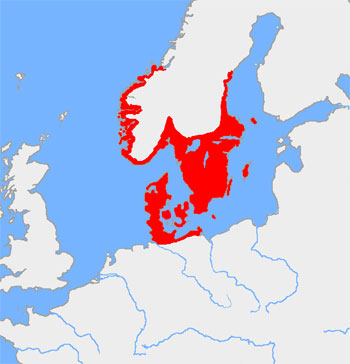
Map of the Nordic Bronze Age Culture c 1200 BC
The Nordic Bronze Age (also Northern Bronze Age) is a period of Scandinavian prehistory from c. 1700–500 BC. The Bronze Age culture of this era succeeded the Late Neolithic Stone Age culture and was followed by the Pre-Roman Iron Age. The archaeological legacy of the Nordic Bronze Age culture is rich, but the ethnic and linguistic affinities of it are unknown, in the absence of written sources. Some scholars also includes sites in what is now northern Germany, Pomerania and Estonia in the Baltic region, as part of its cultural sphere.
http://www.eupedia.com/europe/Haplogroup_I1_Y-DNA.shtml
...
Phylogeny of I1
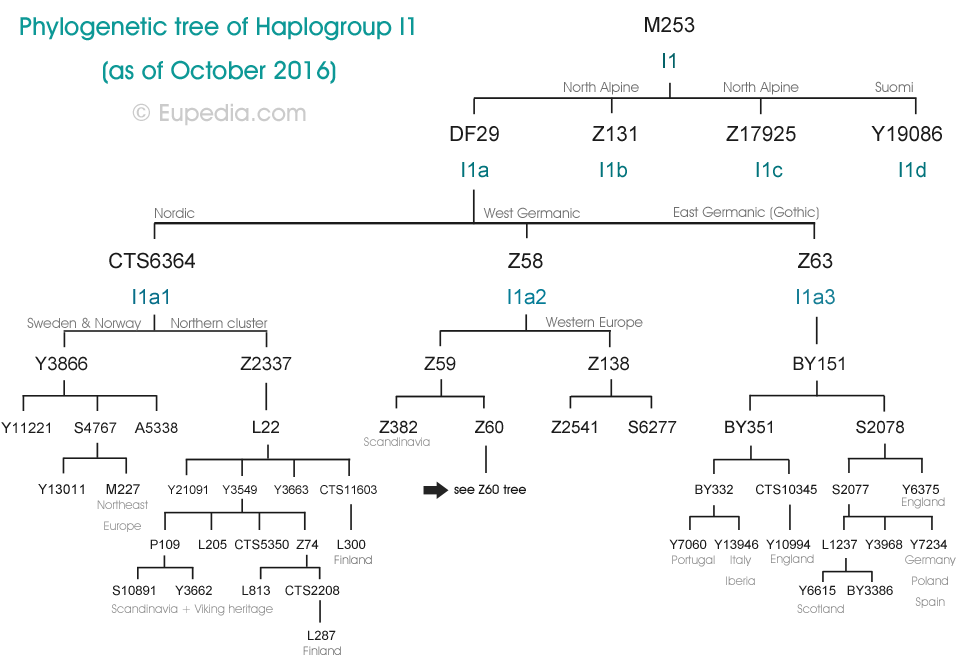
See also:
http://dna.scangen.se/spn/SwedishDNAProjectNews_02_2014.pdf
Haplotype 1 which was described in the first issue and ”Ht 2” refers to
Haplotype 2 which is the one in focus now. Of all paternal lines emerging in
Sweden, Ht 2 is the most frequently occuring. As far as we know, 3.5 % of
paternal lineages from Sweden carry it. Compare this to 2.4 %, the current
corresponding share of Ht 1. (The share of the third most common haplotype is
1,5 %.)
Ht 2 is the modal (ancestral) haplotype of both
haplogroup I-L22 and its subclade I-P109. At DYS390 and DYS385a (the
second and fifth marker in the sequence used by FTDNA), Ht 2 has the allele
values 23 and 14 respectively. Before I-L22 was born, those allele values were
22 and 13. Ht 1 differs from Ht 2 in that DYS385b (the sixth marker) mutated
once more to a value of 15 instead of the previous 14. Ht 1 is modal
haplotype of the groups within I-L22 which Kenneth Nordtvedt calls ”ultra-Norse
types 2−9” (of which ”type 2” has the SNP L813) and that
branched off between 1,500 and 1,800 years ago. (Kenneth Nordtvedt,
http://knordtvedt.home.bresnan.net, The I1modalities.xls, 2013-12-22, and the
I-L22 Project.)
That Ht 2 is older that the earlier described Ht
1 corresponds well with the fact that it also has a larger amount of carriers.
Observe that in each particular test taker’s case his 12-marker haplotype maybe
hasn’t been unchanged since the Bronze age. As with all haplotypes, one must
understand that a certain haplotype doesn’t appear on one branch only. Random
mutations make that some lineages from related branches get the same allelle
values. Also, a lineage which has had Ht 2 for several thousand years
can have been hit by a recent mutation, resulting in the lineage ending up in a
neighbouring haplotype instead. SNP testing confirms which branch one belongs to
....
Families within I-P109 with this haplotype
28 men with the name Chisholm have tested positive for Ht 2. They make
up the core group (including the aristocratic line) of those with this name.
The name was assumed after Cheseholm in Roxburghshire in the southeastern part
of Scotland at some point in time no later than the 13th century. According to
tradition, the family had Norman origin. Sir Robert de Cheseholme was in 1359
appointed constable of the royal castle Urquhart, now a ruin by the lake Loch
Ness. The Chisholms established themselves, through the marriage of his son, as
a highland clan with the castle Erchless, Strathglass (see picture) as their
family seat. The estate was owned by the family until it was sold in 1937. In
addition to these Chisholms, there is a branch of 11 test takers who write their
names Chisolm and Chism. They have a mutation DYS385b = 15 which evidently
appeared after the name was assumed. The first record of the Chisholm coat of
arms with a boar’s head couped is from the year 1296. It later developed to
include to wildmen supporters and a crest with a hand holding aloft a dagger
through the boar’s head.
25 test takers have the name Rice, most
of whom are known descendants of Edmund Rice (1594−1663). He emigrated to
Massachusetts Bay Colony in the 1630s. His background in England is unknown,
except for the fact that he was born in Buckinghamshire. Edmund Rice
ended up owning a lot of land in Sudbury, serving as a deacon, and being an
influential figure in the area. Since ten of his twelve children lived to
adulthood and had children of their own, he has many descendants. The Edmund
Rice (1638) Association, Inc. was founded in 1912. The picture of the memorial,
which was erected in 1913, is from their website. There are other 12-marker
haplotypes that are close to Ht 2 among the Rices, but it’s clear that Ht 2 was
the original within the family.
22 by the name of Gentry can
lead their genealogies back to North Carolina and other places in USA during the
18th century, some of them to Nicholas Gentry, born ca 1655 in Essex,
England.
Most test takers of the name Hamby, 11 ones, have Ht 2. The
name is derived from the estate Hamby in Lincolnshire, England, where one Walter
(ca 1120−ca 1180) was the first known man with the name (he wrote himself de
Hamby).
5 Belangers prove to have a recent connection and with this
haplotype. It’s a French-Canadian family, originally from Normandy, where
François Belanger was born 1586 at Plouigneau. The haplotype is the original one
for this family (two others with the name has one mutation each, on different
markers).
...
The distribution of Ht 2 in different
haplogroups
I-M253 (I1): 69 confirmed examples. I-L214 (also I1): 1
example from England. I-P30 (also I1): 1 example from UK.
I-L22 (I1a1b): 32
examples.
I-P109 (I1a1b1): 38 examples.
I-L205 (I1a1b2):
8 examples, 2 each from England and the Netherlands and 1 from Scotland.
I-Z74 (I1a1b3): 1 example from England. I-Z75 (also I1a1b3): 1 example from
England.
I-L258 (I1a1b3a1): 5 examples, 4 from Finland and 1 from Poland.
I-L813 (I1a1b3b): 1 example from the Netherlands.
I-CTS9346 (without ISOGG
name, below I1a1b3b): 1 example from Sweden.
I-L300 (I1a1b4): 3 examples from
Finland.
I-Z60 (I1a2a1): 1 example from the Netherlands.
I-L573 (I1a2a1c):
1 example from Germany.
I-Z63 (I1a3): 7 examples, 1 each from Czech Republic,
Poland, Russian Federation and UK.
https://www.wikitree.com/wiki/Space:Simonds_yDNA
...
Haplogroups I-M253 (also called I1) and its two subclades I-L22 and
I-P109 are commonly found in men in Scandinavia, the latter two
especially in Norway and Sweden.
According to the National Geographic Society's Genographic Project, the SNP mutation called P109 is "between 1 and 2 percent of male lineages in Sweden and Norway. However, it is rare in the male population of Finland. It is present in trace frequencies of less than 1 percent in Spain, Italy, France, Germany, and the British Isles." I-P109 formed about 4,100 years ago while the Time to Most Recent Common Ancestor for people in this subclade is about 3400 years ago[13] and probably originated in a man who lived in the Oslo fiord between present day Sweden and Norway who was the progenitor of all men with the P109 mutation in their Y-chromosomes including William Simonds and his descendants
It was then spread from Scandinavia to other areas by the Vikings and perhaps also by those Anglo-Saxon groups with origins in what is now Denmark such as the Jutes and Angles. The Vikings raided and settled in the eastern part of England from the 9th to the 11th centuries,[15] whereas the Jutes and Angles came to Britain during the Anglo-Saxon migrations of the 5th century. But because the Danish Vikings and the Jutes and Angles all came to Britain from the same part of Scandinavia, it is difficult at this time to distinguish the Y-DNA of one of these groups from the others and to determine if the ancestors of those with the P109 SNP in Britain were Vikings or Anglo-Saxons
https://www.familytreedna.com/public/yDNA_I-P109/default.aspx?section=yresults
The I-P109 Y-DNA Haplogroup Project - Y-DNA Classic Chart
So I found some Outlaw DNA tests and it
does appear the families in America are related to the familes in the UK.
There are really not enough examples though and not any indication of
Haplogroup (I-P109?) Yet ...
There still is the possibility of
connection to other families .
http://www.ysearch.org/alphalist_lastname.asp?uid=®ion=&letter=O&searchtype=exact&lastname=Outlaw


If two men share a surname, how should the genetic distance at 67 Y-chromosome STR markers be interpreted?
| 1 or 2 | Tightly Related | A 65/67 or 66/67 match between two men who share the same surname (or a variant) indicates a close relationship. It is most likely that they matched 36/37 or 37/37 on a previous Y-DNA test. Very few people achieve this close level of a match. All confidence levels are well within the time frame that surnames were adopted in Western Europe. |
Also for reference the latest I-p109 tree:
https://www.yfull.com/tree/I-P109/
Interesting sweden map of I-P109 distribution ( I1a1b1 old designation)
http://dna.scangen.se/index.php?show=intro&lang=en
The Swedish Haplogroup
Database (SHD) is a free and independent database with the purpose to collect
the haplogroups of historical Swedish persons and thus create a tool to include
this knowledge into traditional genealogy. The aim is also to present statstics
of haplogroup distribution and contribute to the knowledge about pre-historic
migration in Scandinavia. Genetic science shows us that all humans originate in
Africa and we differ very little from each other.
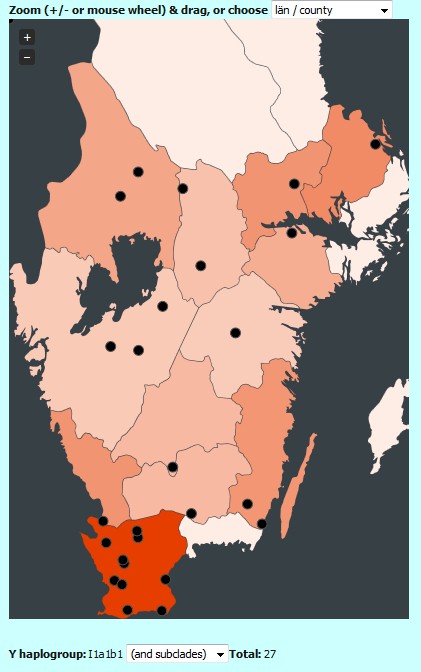
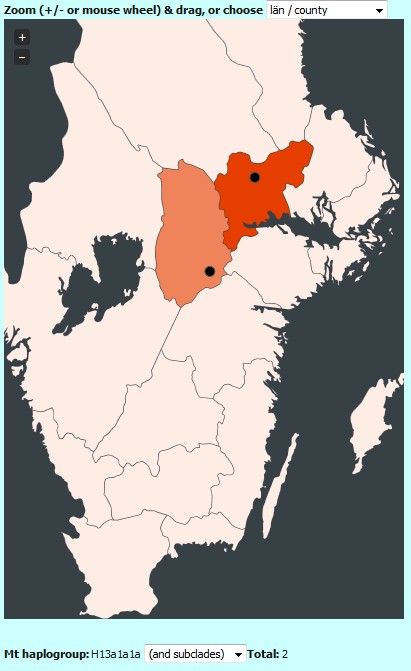
Interesting how Sir Robert de Vere was a signer of the Magna Carta (1215) was "Outlawed" by King John and excommunicated by the Pope and later went on the fifth crusade and died , was also thought to be the real "Robin Hood" ... Then I find this list of English crusaders and Sir William de Waterville is in it too ...
1210 - Roger Utlag - Witness - Lease Steeple Bumpstead Essex - Sir Robert de Vere - Gilbert de Baillol - William de Watevill - Richard de Kann - Cartulary of the Knights of St John
https://www.geni.com/people/Robert-de-Vere-3rd-Earl-of-Oxford/6000000001210373280
http://www.deveresociety.co.uk/pdf/OxfordPedigreeTree.pdf
http://www.findagrave.com/cgi-bin/fg.cgi?page=gr&GRid=51609080&ref=wvr
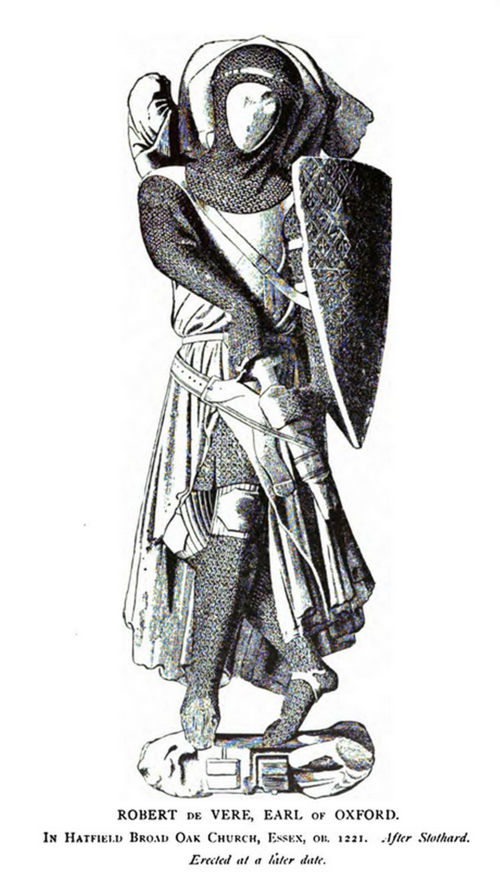 Magna
Charta Surety, 1215
Magna
Charta Surety, 1215
Hereditary Master (Lord) Chamberlain of England
3rd Earl of Oxford.
In the 12th Century, Melusine's descendant, Robert de Vere, 3rd Earl
of Oxford, and legal pretender to the Earldom of Huntingdon, was appointed as
King Richard's steward of the forest lands of Fitzooth. As Lord of the
Greenwood, and titular Herne of the Wild Hunt, he was a popular people's
champion , and, as a result, he was outlawed for taking up arms against King
John. It was he who, subsequently styled Robin Fitzooth, became the prototype
for the popular tales of Robin Hood.
Robert participated in the
ill fated Fifth Crusade with King John, probably as a penance/
peacemaking effort with the church who had excommunicated him during the Magna
Carta struggles. It appears he was on Crusade in the company of his
illegitimate son Roger at the Battle of Damietta, Egypt in 1221, the year they
both died. Sources say he died in Italy of wounds sustained in this
battle, on his way home. The crossed feet on his effigy represent he was on
crusade in his lifetime.
...
Robert de Vere, 3rd Earl of Oxford - Wiki
Robert de
Vere (aft. 1164 - bef. 1221)
....
...
DNA Connections It may be possible to confirm
family relationships with Robert by comparing test results with other carriers
of his Y-chromosome or his mother's mitochondrial DNA. Y-chromosome DNA
test-takers in his direct paternal line on WikiTree: Bob Weaver : Family Tree
DNA Y-DNA Test 37 markers, haplogroup R-M269, Ysearch AFUAH, FTDNA kit #388435
related:
http://gentrekker.com/getperson.php?personID=I13309&tree=Dickinson
...
Saher IV de Quincy Suffix Earl of Winchester Born ca. 1165 Gender Male
Died 3 Nov 1219 Damietta, Egypt The war being over, Saer determined to
fulfil his crusader's vow. In April 1218 he caused the consecration of the abbey
church of Garendon, Leicestershire, of which he was patron in right of his wife,
and in 1219 sailed with Robert Fitzwalter and others for the Holy Land, arriving
at Damietta during its siege by the crusaders. Shortly after his arrival
he fell sick, and commanded that after his death his heart and vitals should be
burnt, and the ashes carried to England and buried at Garendon, which was done.
He died on 3 Nov., and was buried at Acre (Annals of Waverley, an. 1219).
He is described as an accomplished and strenuous warrior (Historia Anglorum, ii.
243). A drawing of his arms is given in the works of Matthew Paris (vi.
Additamenta, 477; compare the engraving from his seal in Doyle, Official
Baronage). He gave many gifts to Garendon Abbey, and was a benefactor to the
canons of Leicester. He died heavily in debt to the king (Rotuli Finium, i. 50).
His wife Margaret died in 1235. He had four sons: Robert, Roger (see below),
Reginald, and a second Robert. Saer also left a daughter Hawyse, who
married Hugh de Vere, earl of Oxford, about 1223,
Jerusalem Delivered: An Epic Poem, in Twenty Cantos; Tr. Into ..., Volume 1
...
List of English Crusaders
...
Sir Robert De Vere
Sir
William De Waterville
...
The List which I have
formed of English Crusaders will be interesting to the antiquary. For a
few of the names, I have been indebted to J. C. Sneyd Kynnersley, Esq., St.
John's College, Cambridge, and for a few to his Grace the Duke of Newcastle and
other descendants of crusading families ; but the mass have been gleaned from a
patient perusal of monkish annals. It is much to be regretted that of
the thousands who assumed the Cross in England, so few have been recorded by our
old chroniclers : in consulting however the MSS. in the Ashmolean
Museum, I was so fortunate as to find a list of those who accompanied King
Richard*, which made a considerable addition to their number ; others, which may
have escaped my own research, will perhaps be furnished by those who are more
deeply read in county histories, in genealogy, and heraldry, and who may derive
gratification from this first attempt to chronicle the names of those, who,
crowding from the English shores, participated in the fame of Duke Robert or
Cceur de Lion, of Prince Edward, or of Salisbury. Mr. Mills has, it is true, in
his admirable " History of the Crusades," portrayed in its real colours the
nature of those singular expeditions ; but who would not willingly continue the
illusion which, whether derived from the songs of our early minstrels, or the
charming tale of Tasso, invests the character
of the Crusader with I know not
what of devotion, generosity, and love?
THE MEMORY OF PAST LOVE.
Voice animetta mia*.
My life, my dulcet little soul ! oh when
Shall I
return to the dear spot, or near it,
Where we were so conjoined, and so
divided ?
But a fond glance of the' eye, a pleasant smile,
A courteous
salutation, a kind nod,
Two blessed love-words, and two sighs, shall be
Of
my so long, long sufferings the reward, —
Or rather the fresh tortures, —
ties, bonds, chains,
Torches, and darts, and arrows, to transfix,
Bind,
and inflame me still !
...
Canto IX. JERUSALEM DELIVERED.
459
LXXXVIII.
Nor thus content, he from his steed alights,
And makes
fierce battle with the corse he slew,
Like a struck mastiff that in vengeance
bites
The stone some passenger in anger threw.
O vain relief of anguish,
to pursue
With rage the dust insensible to pain !
But meanwhile Godfrey
and his circling crew
Of Paladins, against the Soldan's train
Spent not in
vain their powers, struck not their blows in vain.
LXXXIX.
A thousand
Turks were there from head to heel
Sheathed in fine mail, with plated shields
; their frame,
Untired by toil, was stubborn as the steel
That armed their
limbs, their daring souls the same, —
Versed in all movements of the martial
game :
The Soldan's ancient body-guard, they passed
With him to the
Arabian wilds when came
His evil hour, and to his fortunes fast
Adhered
through bright and dark, confederates to the last.
https://books.google.com/books/about/Jerusalem_Delivered.html?id=a1k9AAAAYAAJ
JERUSALEM DELIVERED; AN EPIC POEM, IN TWENTY CANTOS; Vol 2
St John the Baptist,
Little Maplestead, Essex
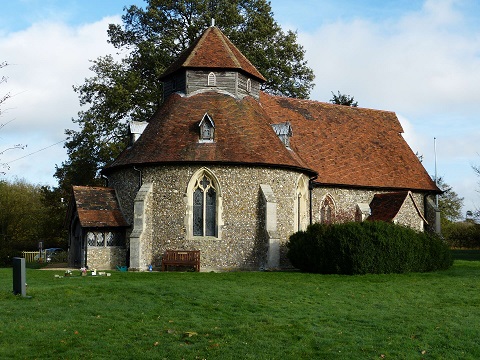 History
History
The Domesday Survey does not distinguish between Great and Little
Maplestead, and identifies three holdings in the two villages. Half a
hide was held by Osmund from John FitzWaleran in 1086, that belonged to Grim as
a manor in 1066. Ilger held half a hide from Robert Gernon, that belonged to
Wulfwine in 1066, and the wife of Aubrey de Vere appropriated 5 free men with 1¼
acres here, that Tidbald held under her. In addition, and perhaps of more
significance, is the manor of ‘Napstead’ in Little Maplestead, which was
held by the wife of Aubrey de Vere from the Bishop of Bayeux in 1086,
and by 8 free men in 1066, and was assessed at 22½ acres. It is not clear which
of these holdings is relevant to the later history, which is that the village
and the church were given by Juliana FitzAudelin, the daughter of Robert
Dosnel and wife of William FitzAudelin, Henry II’s steward, to the Knights
Hospitallers, a grant confirmed by her husband in 1186.
see also :
Richard Le Utlawe - 1260 - Essex
1259 -
A pitched battle was fought in Syria, between the Templars and Hospitallers.
The Templars were defeated
1260 -
Witness Richard le Utlawe - Essex - Grant of Rent
William de Wateville to John de Vallibus and his heirs of land in
Hempstead, Essex witnessed by Sir Nicholas Peche,
Sir Andrew de Helyun, Sir Simon Peche, Philip de Codree, John
de Bosco, Richard de Kanne, Richard le Utlawe, Hugh de Sanford,
Roger de Reymes, Geoffrey de Bello, Simon Clericus - 44 Henry III
1285 - Hospitaller Charter of Ida daughter of the late Richard Utlaw of the five acres of land and half an acre of meadow, with appurtenances. - Roger [ son of Richard ] Outlaw ( of Bumpstead Helion ), Ida daughter of Richard
Some questions might be : Why are all these (important) people gathered together for this occasion of a rental agreement?
The Hospitaller Cartulary in the British Library: Michael Gervers:
9780888440501: Amazon.com: Books
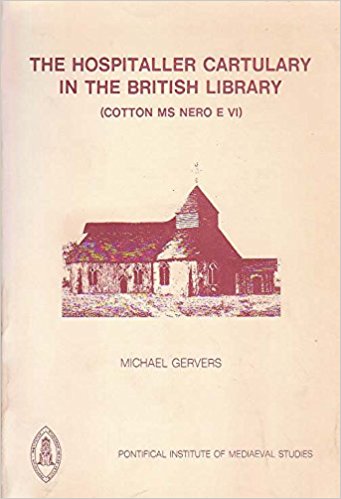
Notice Robert De Vere is mentioned -
then later Ida Outlaw in 1285 in Bumstead Helion ( next door) , So the early
1210 Roger Outlaw was probably near also .. Crusading neigbors of Hospitallers
and Templers
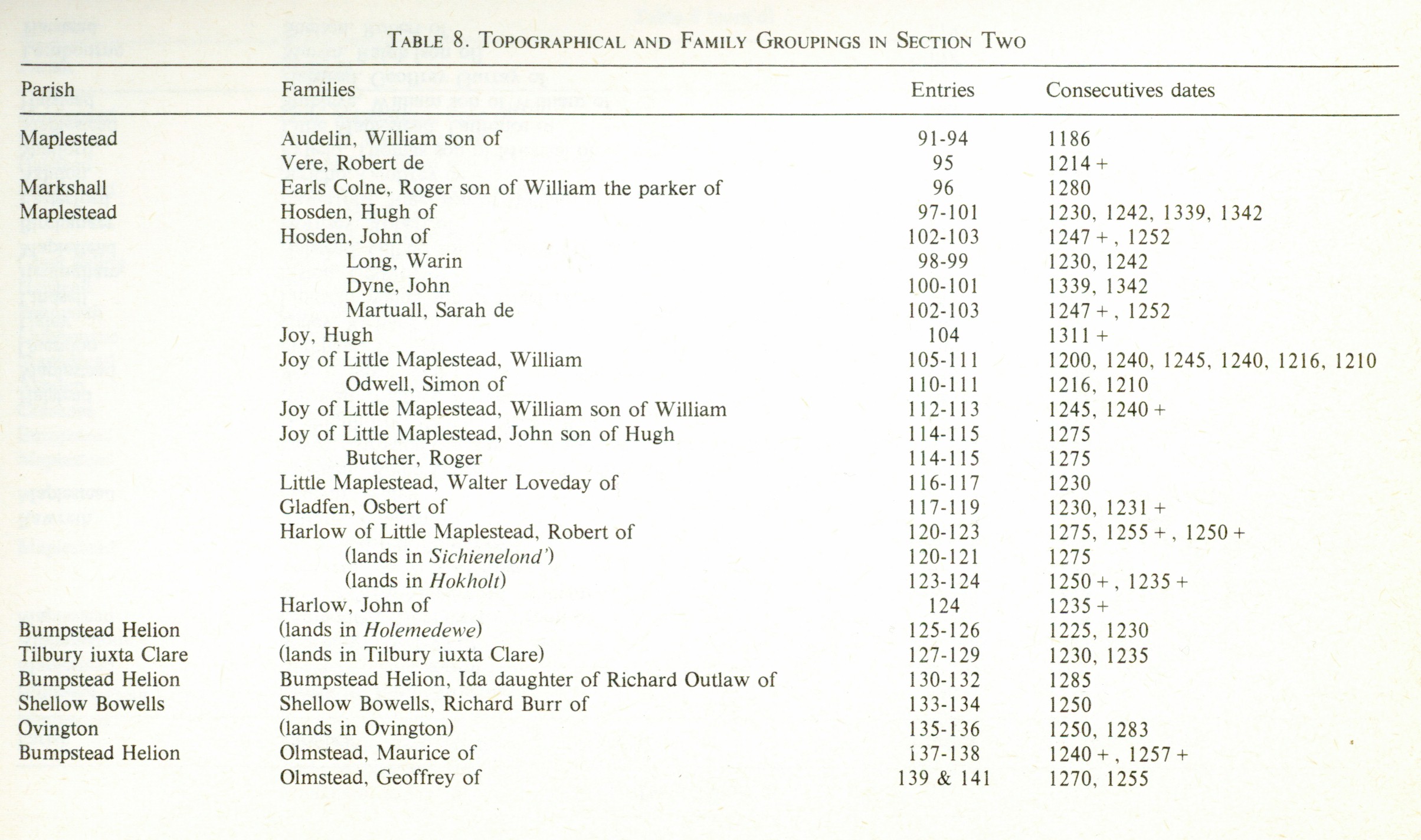
....
The papal censure was disregarded by the Templars
; and though they professed obedience to the legate of the pope in 1219, when he
headed the
expedition into Egypt, it was they who really directed the legate.
In this expedition, and particularly in the siege of Damietta, the
knights greatly distinguished themselves ;
but when the
Emperor Frederick II. undertook the crusade in 1228, they gave him all the
opposition in their power, and
wrote to the sultan of Egypt to inform him of
the emperor's plans. The sultan sent the letter to Frederick, who, on his return
to Europe, revenged
himself upon the order by seizing all its possessions
throughout Italy and Sicily.
In attacking the Templars, and
defending this confiscation of their property, the emperor made it an
important charge against them, that
they were friendly to the Moslems.
' We know on good authority,' said he, ' that sultans and their trains are
received with pompous alacrity
within the gates of the temple, and that the
Templars suffer them to celebrate secular plays, and to perform their
superstitious rites with invocation
of Mohammed.' The Templars
retaliated by dispossessing the Teutonic knights of all their possessions in
Syria, and entered into an alliance with
the emir of Damascus against the
Hospitallers.
The invasion of the Turks compelled the rival orders to unite for their
common safety ; but they suffered a severe defeat near Damascus, in which the
master and 300 knights
were slain. Only Acre now remained in possession of
the Christians, and the Templars appear at this time to have meditated a
complete retreat
from the East ; but the animosity which had been
long gathering between this or der and that of the Hospitallers at length burst
into a flame,
and in 1259 a pitched battle was fought between them, in which
the Templars were completely routed. From this period no event of
importance in the annals of the order occurred until 1291, when Acre was taken
by storm by the Moslems, and the remnant of the Templars sought refuge
in the
island of Cyprus.
| - - - - - - - - - - - -
I found it interesting Ida Outlaw is a
widow but we don't know who her husband was ... yet it was more important that
she was the daughter of "Sir" Richard Outlawe ..
so here is
the actual document reference to her lease ( to earn income) to the Hospitallers
and another document explaning widowhood in the 1300's :
http://deeds.library.utoronto.ca/charters/00880130
Know all men
present and future know that I, Ida, had once been the daughter of Sir
Richard le Outlaw of Bumpstead Helyun this in the pure widowhood, and
the manner of the use of my right have given, granted and by this my present
charter have confirmed to God and the Blessed Mary and to St John the
Baptist and the brethren of the Hospital of St. John of Jerusalem in England;
Maplestead residing, or of in the same place serving God, for the
salvation of the souls of my ancestors, have five acres of land and half
an acre of meadow, with the appurtenances, lying in the Bradecroft, to
have and to hold of me and my heirs or my assigns, the aforesaid brothers, and
their successors, freely, quietly, well and in peace, for ever paying for them
annually, to me me or assigns brothers and their successors guarantee all men
and all fully defend the aforesaid five and a half acre of land with its
properties as previously indicated by that service free to all men and women
permanently Witness Andrea Helyun William Olmestede Giovanni Olmestede Stephan,
son of John Stephen Thomas Beucham soldiers Lancelyn Launcelyn John William
Panymere and others Given the road iustic [iariis] Chelmereford year in the
reign of king Edward
https://etd.ohiolink.edu/rws_etd/document/get/osu1211560325/inline
ii
ABSTRACT
Women in late medieval London received significant portions
of their husbands' estate as dower - anywhere from one-third to one-half.
Laws may have limited the widows' ownership to their lifetimes, but the widows
were free to collect any financial interests the property accrued during their
possession
...
They rarely granted the property for their lifetimes, and
instead used this portion of their holdings to earn income through quitclaims.
After the plague, however, citizens retained larger property holdings,
thereby increasing their widows' dowers. In the second half of the
fourteenth century, widows alienated these additional holdings in return for
financial profits. Throughout the century, however, widows generally conformed
to borough customs. ...
http://magnacarta.cmp.uea.ac.uk/read/feature_of_the_month/Mar_2015
...
The King was signed with the cross at London, on Ash Wednesday (4 March 1215) by
William bishop of London, and with him, or after him, many of his associates,
very much at his prompting, donning white crosses, like the King's, or like that
of his brother or father. It was the ancient custom that the English be signed
with white crosses, just as the French were signed with red
Maine Coon
 "Some say the Vikings brought him to North America, centuries before
Columbus sailed the ocean blue,"
"Some say the Vikings brought him to North America, centuries before
Columbus sailed the ocean blue,"
http://cattime.com/cat-breeds/maine-coon-cats#/slide/1
History
The
Maine Coon is a native New Englander, hailing from Maine, where he was a popular
mouser, farm cat and, most likely, ship's cat, at least as far back as the early
19th century. He is a natural breed and little is known of his origins. Some say
the Vikings brought him to North America, centuries before Columbus sailed the
ocean blue, others that he is the descendant of longhaired cats belonging to
Marie Antoinette, sent to America in advance of the doomed queen, who had hoped
to escape there. Sea captains may have brought back longhaired cats that then
mated with local shorthaired cats. One thing is for sure: the Maine Coon is not
the result of a mating between a cat and a raccoon, even if his brown tabby coat
and furry ringed tail suggest that biological impossibility. The resemblance is,
however, how the cats got their name; in fact, Maine Coons that didn't have the
brown tabby coat were called Maine Shags.
...
... they are the official
state cat of Maine.
https://www.scientificamerican.com/article/how-cats-conquered-the-world-and-a-few-viking-ships/
How Cats Conquered the World (and a Few Viking Ships)
A
large-scale study of ancient feline DNA charts the domestication and global
spread of house cats
By Ewen Callaway, Nature magazine on September 20, 2016
...
Sea-faring people probably kept cats to keep rodents in
check, says Geigl, whose team also found cat remains with this
maternal DNA lineage at a Viking site dating to between the eighth and eleventh
century A.D. in northern Germany.
"There are so many interesting
observations" in the study, says Pontus Skoglund, a population geneticist at
Harvard Medical School in Boston, Massachusetts.
"I didn't even
know there were Viking cats."
He was also impressed by the fact
that Geigl's team was able to discern real population shifts from mitochondrial
DNA, which traces only a single maternal lineage. Nonetheless, Skoglund thinks
that nuclear DNA--which provides information about more of an individual's
ancestors--could address lingering questions about cat domestication and spread,
such as their relationship to wild cats, with which they still interbreed.
...
see also:
http://www.smithsonianmag.com/smart-news/dna-study-details-spread-cats-around-world-180960573/
And:
http://www.nature.com/news/how-cats-conquered-the-world-and-a-few-viking-ships-1.20643
Maine Coon and Forest Cat related ? - Probably ...
http://nowtrendingstory.com/norwegian-forest-cat-breed-information/
The Norwegian Forest Cat comes from the native of Norway, with a history
going back hundreds and maybe thousands of years. He features in many
fairy tale stories and legends. One of a popular legend describes that
six gigantic cats pull the Chariot of Norse goddess Freya. Where any
how these cats came into existence is a long unsolved mystery.
...
It is very much likely that the Norwegian Forest Cats were serving on
the Viking Ship as the cats of the ship, also called mousers.
...
http://nowtrendingstory.com/wp-content/uploads/2017/03/Norwegian-Forest-Cat-3.jpg

http://www.winterfyre.com/
http://www.winterfyre.com/mandy1.jpg
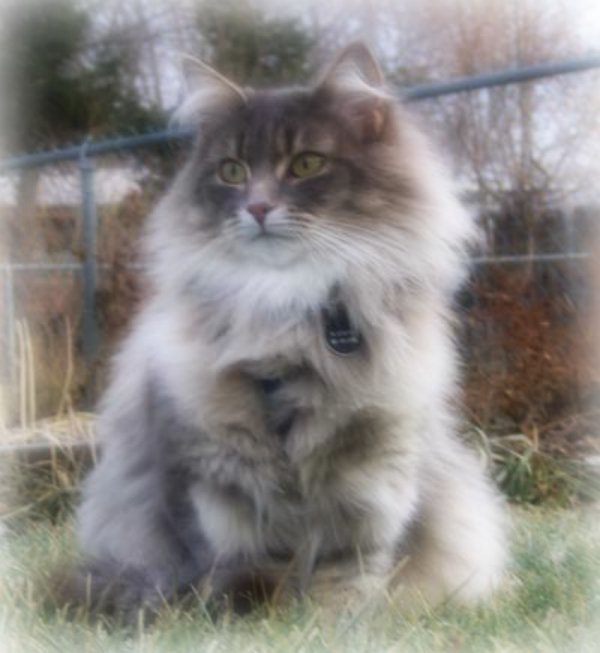
http://www.winterfyre.com/testing/
https://www.vgl.ucdavis.edu/services/cat/ancestry/faq.php
Cat
Ancestry - Frequently Asked Questions (FAQs)
...
FAQ Answers
. About Cat Ancestry
What information will the cat ancestry test provide?
Cat Ancestry is a novelty test to investigate ancestry and determine which
of the 8 geographic regions your cat descends from: Western Europe, Egypt, East
Mediterranean, Iran/Iraq, Arabian Sea, India, South Asia and East Asia.
Your cat's sample will be compared to the 29 reference populations from four of
the regions: Western Europe, South Asia, Eastern Mediterranean and Arabian Sea.
If your cat associates strongly with one of the 29 reference populations, the
information is reported. In addition, the Cat Ancestry report includes the
genetics of your cat's coat colors, fur length and fur type.
| - - -
http://mainecoon.org/maine-coons-vs-norwegian-forest-cats/
Maine
Coons vs. Norwegian Forest Cats
Maine Coon cats and Norwegian
Forest cats look very similar, and some experts that believe that the Maine Coon
is a descendant of the Norwegian Forest cats since they share so many similar
traits.
They are both large breeds of cats. They both have long silky
coats. They are both well known for being outgoing and friendly but there are
some differences in both appearance and personality. Maine Coons are well-known
for their intelligence and their ability for quickly learning new things.
Maine Coons also really enjoy the company of people and are very loyal.
Norwegian Forest Cats are also very intelligent and easy to train, but they are
not that interested in the loyalty part if you are not willing to interact with
them.
...
http://wickedyankee.blogspot.com/2011/12/maine-coons-that-yankee-cat.html
Maine Coons - That Yankee Cat
....
in Ring of
Seasons: Iceland - Its Culture and History, author Terry G. Lacy states that
a DNA connection has been found between cats from Iceland and the cat
populations in other places that have or may have experienced Norse visitation.
She lists New York and Boston as being two of these areas. However, she also
states that there have been no archeological findings to support this connection
so far. Therefore, the theory is interesting, but so far unproven.
If
remains of cats are found in areas of Norse settlement in North America or more
DNA research is done to find connections between Maine Coons and Norwegian
Forest Cats, I'd be happy to look into this idea further.
http://archiver.rootsweb.ancestry.com/th/read/GENEALOGY-DNA/2006-03/1142992542
> I mention an older study below:
>
> Adelsteinson, S., and B.
Blumenberg.
Possible Norse origin for two Northeastern USA cat
populations. Zeitschrift für Tierzüchtung und Züchtungsbiologie 100
(1983): 161-174. They consider a possible Norse/Viking origin for two
northeastern U.S. cat populations.
These clearly
demonstrate similarity to Scandinavian felines on the basis of genetic distance
calculations reinforced by discriminant analysis. The possible
biogeographic reality of such mathematical relationships is discussed in
reference to genetic drift and available historical and ethnographic
information. [Sorenson] Cited in Bergersen [has "Adalsteinson"], Sorenson
>
http://www.sciencedirect.com/science/article/pii/S0888754307002510
https://ars.els-cdn.com/content/image/1-s2.0-S0888754307002510-gr2.jpg
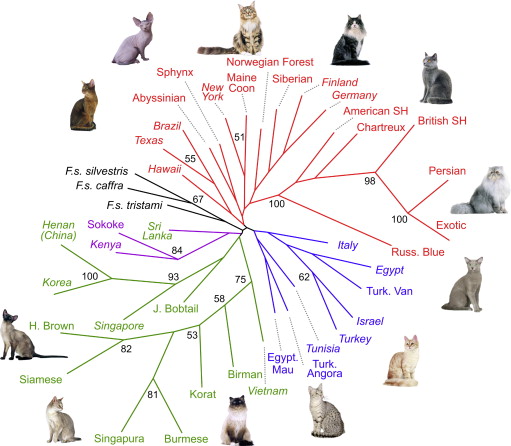
Fig. 2.
Neighbor-joining tree of cat breeds and populations.
The phylogenetic tree was constructed using Cavalli-Sforza's chord distance.
Bootstrap values above 50% are presented on relationship nodes. Asian (green),
Western European (red), East African (purple), Mediterranean basin (blue), and
wildcat (black) populations form strongly supported monophyletic branches.
European and African wildcats are closely related, whereas short branches of
most all other populations indicate close relationships of these breeds and
populations. Random-bred populations are indicated in italics, breeds are in
standard font. Cat photographs courtesy of Royal Canin and Richard Katris of
Chanan Photography.
Viking
trade in red squirrels may have spread leprosy
Red squirrels
traded by Vikings could have brought leprosy to pre-medieval England, according
to archaeologists.
Research has revealed that a pre-Norman skull found in
Hoxne in Suffolk has a leprosy strain closely related to a type known to affect
squirrels.
The strain has also been found in Medieval Scandinavian
skeletons.
Cambridge University's Sarah Inskip said contact with the
"highly-prized squirrel pelt and meat" traded by Vikings could have spread the
disease.
Radiocarbon dating revealed the woman's skull, which is held at
Diss Museum in Norfolk, dates to between 885 and 1015 AD.
It has the same
strain of leprosy as that identified in skeletal remains found in Medieval
Denmark and Sweden.
Dr Inskip said: "That [leprosy] may also come from
squirrels is an interesting idea."
King's Lynn and Yarmouth in
Norfolk were "significant ports for fur imports" from Denmark and Sweden at this
time, she added.
The animals were also sometimes kept as pets.
| - - - -
http://nrocat.norfolk.gov.uk/DServe/dserve.exe?dsqServer=NCC3CL01&dsqIni=dserve.ini&dsqApp=Archive&dsqCmd=Show.tcl&dsqDb=Catalog&dsqPos=0&dsqSearch=%28%28text%29%3D%27%20Laurence%20Outlaw%20utlator%27%29
1200-1250 - Deed of grant, Lynn - 1d annual rent from a certain [piece of land]
4 feet wide in Damgate held by Peter Strac - Grant by Laurence Outlaw (utlator)
of Len [Lynn] to the Hospital of the Blessed Mary Magdalen of Len and to the
infirm brothers there for the souls of his parents and his benefactors, the 1d
to come from his purse during his lifetime
Witnesses: Robert the
mayor of Len, Ralph Kelloc, Adam de Gernemut, William clerk of Gernemut, Robert
the son of David, Richard de Brecha., William son of Aelld., William son of
Milon, John de Geywdia, Michael de Beaw., Yvone de Lincoln, William the son of
Richard, John the son of Astin and many others
Endorsed as relating to Lenne.
Medieval Leper Hospitals in England: An Archaeological Perspective
By SIMON
ROFFEY
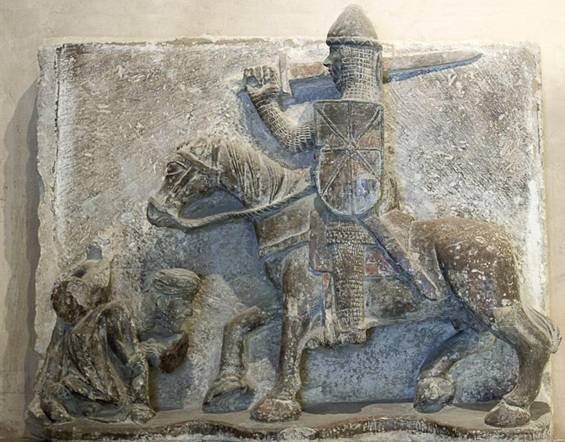
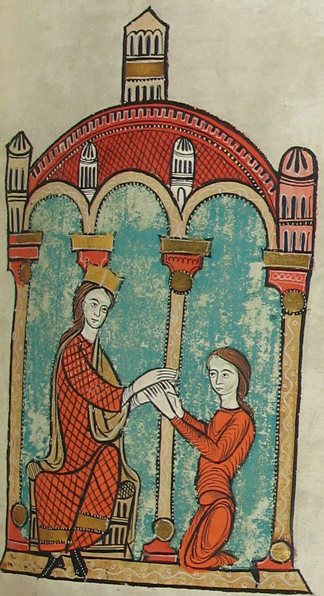
Normans in Catalonia
https://www.researchgate.net/publication/240431921_Norman_crusaders_in_the_Catalan_reconquest_Robert_Burdet_and_the_principality_of_Tarragona_1129-55
Norman crusaders in the Catalan reconquest: Robert Burdet and the principality
of Tarragona, 1129-55
Article · March 1981 with 24 Reads
Abstract
A Norman adventurer, Robert Burdet, while participating in the Reconquista,
established a short-lived crusader principality at Tarragona.
This Norman
gained fame after 1114, first serving Alfonso I el Batallador (‘The Warrior’) of
Aragón in the wars against the Banu Hūd of Zaragoza; thereafter he was
contracted by Archbishop Oleguer Bonestruga of Tarragona, the primate of
northeastern Spain after 1118 and a papal legate after 1123, to assume in 1129
the secular lordship of Tarragona which had been constituted by the comital
house of Barcelona as a papal fief and ecclesiastical principality. After this
prelate's death in 1137, the Norman held this frontier and attempted to found an
autonomous crusader state, but in 1146 the new archbishop, Bernard Tort, began
to re-impose ecclesiastical control over Tarragona.
At the same time, the
house of Barcelona inherited the royal title from Aragón, thus forming the crown
of Aragón by merging the former kingdom with the Catalan counties and reviving
the crusade against Muslim Lérida and Tortosa which fell in 1148 and 1149.
The archbishop and count moved against the Normans to integrate their
principality into the new Aragó-Catalan federation. Prince Robert lost much of
his power before his death in 1155, and his heirs were reduced to vassalage to
Barcelona and subservience to their ecclesiastical lord, the archbishop of
Tarragona. Civil war broke out after 1155 and the expulsion of the Normans by
1177 brought their principality to an end.
Norman crusaders in the
Catalan reconquest: Robert Burdet and the principality of Tarragona, 1129-55.
Available from:
https://www.researchgate.net/publication/240431921_Norman_crusaders_in_the_Catalan_reconquest_Robert_Burdet_and_the_principality_of_Tarragona_1129-55
[accessed Nov 27 2017].
https://en.wikipedia.org/wiki/Robert_d%27Aguil%C3%B3
Robert d'Aguiló (c.
1100 – c. 1159), also known as Robert Bordet, was a Norman knight who moved from
Normandy to Catalonia in the early 12th century. He was a native of Cullei
(modern Rabodanges in Orne, France), as reported by Orderic Vitalis, and his
name d'Aguiló is a catalanized form of "d'Aculley" or "de Culley" that he
adopted after marrying the daughter of a Catalan noble.
In 1124 Robert
became governor of the newly conquered territory of Tudela and held that post
for the next two years. Three years after his term office, on 14 March 1129, he
was ceded secular authority in the district of Tarragona by Olegarius, Bishop of
Barcelona, with the title of "Prince of Tarragona" (princeps Tarraconensis),
effectively the archiepiscopate's vidame or defensor (defender, advocate).[1][2]
His position in Tarragona he maintained until 1153.
On 24 January 1150
Robert granted the lordship of Riudoms to Arnau de Palomar. In 1149 Robert
granted a charter to the city of Tarragona, and appointed one Guillem (William)
as lord of the city, but Guillem was forced to resign in 1157. This occurred
after he attempted to transfer his rights in the city to the Count of Barcelona
but Robert rejected the agreement. On 29 April 1157 the lordship of Reus was
granted by Robert to the Church of Tarragona but it was transferred to Bertran
de Castellet less than two months later on 3 June. Two years later (1159) an
ephemeral agreement between the count, the bishop, and Robert was reached.
Robert was married to Agnes Sibylla (died 1170), and had four sons by her:
Guillem (William, died 1168), Robert, Ricard (Richard), and Berenguer (Berengar,
who in conjunction with Robert, assassinated Bishop Hug de Cervelló in 1171).
Later:
https://en.wikipedia.org/wiki/Ramon_Berenguer_IV,_Count_of_Barcelona
Ramon
Berenguer IV (Catalan pronunciation: [rəˈmom bəɾəŋˈɡe]; c. 1114[1] – 6 August
1162, Anglicized Raymond Berengar IV), sometimes called the Saint, was the Count
of Barcelona who brought about the union of his County of Barcelona with the
Kingdom of Aragon to form the Crown of Aragon.
The Chronicle of San Juan
de la Peña said he was, "[a] man of particularly great nobility, prudence, and
probity, of lively temperament, high counsel, great bravery, and steady
intellect, who displayed great temperance in all his actions. He was handsome in
appearance, with a large body and very well-proportioned limbs."
Crusades
and wars
In the middle years of his rule, Ramon Berenguer turned his
attention to campaigns against the Moors. In October 1147, as part of the Second
Crusade, he helped Castile to conquer Almería. He then invaded the lands of the
Almoravid taifa kingdoms of Valencia and Murcia. In December 1148, he captured
Tortosa after a five-month siege with the help of Southern French, Anglo-Norman
and Genoese crusaders.[3] (When Moors later tried to recapture Tortosa, the
women put up such a spirited defense that Berenger created for them the Order of
the Hatchet.) The next year, Fraga, Lleida and Mequinenza in the confluence of
the Segre and Ebro rivers fell to his army. The reconquista of modern Catalonia
was completed.
Ramon Berenguer also campaigned in Provence, helping his
brother Berenguer Ramon and his infant nephew Ramon Berenguer II against the
Counts of Toulouse. During the minority of Ramon Berenguer II, the Count of
Barcelona also acted as the regent of Provence (between 1144 and 1157). In 1151,
Ramon signed the Treaty of Tudilén with Alfonso VII of León and Castile. The
treaty defined the zones of conquest in Andalusia as an attempt to prevent the
two rulers from coming into conflict. Also in 1151, Ramon Berenguer founded and
endowed the royal monastery of Poblet. In 1154, he accepted the regency of
Gaston V of Béarn in return for the Bearnese nobles rendering him homage at
Canfranc, thus uniting that small principality with the growing Aragonese
empire.
https://en.wikipedia.org/wiki/Siege_of_Tortosa_(1148)
The Siege of
Tortosa (1 July – 30 December 1148) was a military action of the Second Crusade
(1147–49) in Spain. A multinational force under the command of Count Raymond
Berengar IV of Barcelona besieged the city of Tortosa (Arabic Ṭurṭūs̲h̲a), then
a part of the Almoravid Emirate, for seven months before the garrison
surrendered.
...
Participants in the siege of Tortosa were even called
"pilgrims" (peregrini) like those en route to the Holy Land.
...
The
conquest of Tortosa was a major event in the Reconquista of the Ebro Valley.
Raymond Berengar IV followed it up with the conquest of Lleida on his own,
without Genoese assistance or papal approval, in 1149.
...
Besides the
army of Aragonese, Catalans and Occitans recruited from the three territories
under Raymond Berengar's rule and the Genoese army recruited by him in 1146, the
army that besieged Tortosa was joined by crusaders from northern Europe, namely
Englishmen, Flemings and Normans.[5] It is probable that some or all of the
English, Flemish and Norman crusaders were veterans of the Lisbon campaign,
although another portion of that Anglo-Flemish army had gone on to the Holy Land
and was at that time participating in the Siege of Damascus. The only source to
explicitly link the English at Tortosa with those at Lisbon is the Royal
Chronicle of Cologne, which says that afterwards they continued on to the Holy
Land
https://en.wikipedia.org/wiki/Order_of_the_Hatchet
The Order
of the Hatchet (Sp. Orden del Hacha) is an female honorific order supposedly
founded in 1149, bestowed upon the women of the town of Tortosa, in Catalonia
(Spain).
This order was founded during the Reconquista to honor women
combatants in the site of Tortosa against Muslims. During that year, amid heavy
fighting between the two fronts, Muslims besieged Tortosa after a withdrawal of
Berenguer. In the absence of men to defend the city, women joined the fight,
dressing as men[1] and attacking with hatchets and anything else they could lay
their hands on. They successfully repelled the attackers. Their participation
was essential to the defense of Tortosa. In appreciation of these facts, Count
Ramon Berenguer instituted the order of the hatchet for women who participated
in that defense, which brought them privileges and tax exemptions, among other
things.
| - - - -
https://eprints.nottingham.ac.uk/cgi/users/login?target=http%3A%2F%2Feprints.nottingham.ac.uk%2F283%2F2%2FNorman_and_AngloNorman.pdf
Participation in the Iberian Reconquista c.1018 - c.1248 By Lucas
Villegas-Aristizábal BA (Hons), MA pdf ... Chapter IV, addresses the large
contribution of the Anglo-Normans as part of the Second Crusade and their
motivations and the impact of their arrival on the Iberian realms ... Harvey of
Glanville was the leader of the East Anglian contingent in the Lisbon
expedition. From the lack of documentary sources about his life and his
relationship with the other Glanvilles in East Anglia, we might assume that
whilst he was perhaps important and influential among the small landowners of
his region he was not a powerful lord who could pay a full retinue of armoured
knights to go with him to Iberia. However, there are a few documents which
predate his departure for Spain. Two of these show him as a witness to Stephen's
charters, which suggest that at least for a time he was a loyal subject to the
king in the years before the crusade.427 Perhaps his leadership, just as it is
implied in De expugnatione Lyxbonensi, was achieved as part of a process of
election based perhaps on his personal prestige among his peers. ... Details of
other Englishmen in the Iberian campaigns of the Second Crusade have also
survived in documents relating to the granting of lands made after the conquest
of Tortosa.432 The most notable of them, because of the abundance of documentary
sources about them, are ‘Gilbert’, ‘Osbert’, and ‘Jordan’.’433 Unfortunately
because of the cryptic form of the names of these Englishmen who appear mostly
with the surname of Anglici or Angles, it is hard to identify exactly their
place of origin in England. However, there are two groups of English in Tortosa
whose surnames Savigne and Caron seem to link them directly with East Anglia,
which implies that some other participants were also from this area.434 It is
likely that those involved on the Lisbon campaign and the Tortosa campaign were
members of the same expedition, since there is no mention of the formation of a
crusading expedition in England except for those who went to Lisbon. Lisbon
Cathedral - In the year 1147, the city was reconquered by an army composed of
Portuguese soldiers led by King Afonso Henriques and North European crusaders
taking part on the Second Crusade (see Siege of Lisbon). An English crusader
named Gilbert of Hastings was placed as bishop, and a new cathedral was built on
the site of the main mosque of Lisbon Gilbert of Hastings - died 1166) was an
English monk in the Christian army of the Second Crusade that fought in the
siege of Lisbon. After the victory, he was chosen to be Bishop of Lisbon Robert
d'Aguiló - (c. 1100 – c. 1159), also known as Robert Bordet, was a Norman
adventurer who moved from Normandy to Catalonia in the early 12th century. He
was a native of Cullei (modern Rabodanges in Orne, France), as reported by
Orderic Vitalis, and his name d'Aguiló is a catalanized form of "d'Aculley" or
"de Culley" that he adopted after marrying the daughter of a Catalan noble.
Tortosa - After more than 400 years of Muslim rule, the city was conquered by
the Count Ramon Berenguer IV of Barcelona in 1148, as part of the Second
Crusade. Because of the crusading appeal made by Pope Eugene III and his
representative Nicholas Brakespear (the future Pope Hadrian IV), the siege
received the aid of crusaders from multiple nationalities (Genovese,
Anglo-Normans, Normans, Southern-French, Germans, Flemish and Dutch), who were
on their way to the Holy Land. The siege of Tortosa was narrated by the Genovese
chronicler and diplomat Caffaro. After its conquest, the city and its territory
were divided among the victors, with multiple lands being granted to foreign
crusaders and to the military and religious orders
https://en.wikipedia.org/wiki/Siege_of_Lisbon
Siege of Lisbon - from
July 1 to October 25, 1147, was the military action that brought the
city of Lisbon under definitive Portuguese control and expelled its Moorish
overlords. The Siege of Lisbon was one of the few Christian victories of the
Second Crusade—it was "the only success of the universal operation undertaken by
the pilgrim army," The Fall of Edessa in 1144 led to a call for a new crusade by
Pope Eugene III in 1145 and 1146.
In the spring of 1147, the Pope
authorized the crusade in the Iberian peninsula. He also authorized Alfonso VII
of León and Castile to equate his campaigns against the Moors with the rest of
the Second Crusade. In May 1147, the first contingents of crusaders left from
Dartmouth in England for the Holy Land. Bad weather forced the ships to stop on
the Portuguese coast, at the northern city of Porto on June 16, 1147. There they
were convinced to meet with King Afonso I of Portugal. The crusaders agreed to
help the King attack Lisbon, with a solemn agreement that offered to the
crusaders the pillage of the city's goods and the ransom money for expected
prisoners. The siege began on July 1. After four months, the Moorish rulers
agreed to surrender on October 24, primarily because of hunger within the city.
Most of the crusaders settled in the newly captured city, but some of the
crusaders set sail and continued to the Holy Land. Lisbon eventually became
capital city of the Kingdom of Portugal, in 1255.
...
On May
19, 1147, the first contingents of crusaders left from Dartmouth in England,
consisting of Flemish, Frisian, Norman, English, and Scottish crusaders, and
some from Cologne,[6] who collectively considered themselves
"Franks".[7] No prince or king led this part of the crusade, England at the time
being in the midst of The Anarchy. The fleet was commanded by Henry
Glanville, Constable of Suffolk.[8][9] Other crusader captains included
Arnold III of Aerschot, Christian of Ghistelles, Simon of Dover, Andrew of
London, and Saher of Archelle ... Some of the crusaders set sail and continued
to the Holy Land.[8] However, most of the crusaders settled in the newly
captured city, thus boosting the number of Christian supporters in Iberia.
Gilbert of Hastings was elected bishop. This is seen[by whom?] as the
beginning of the historic relationship between England and Portugal which would
later form the Anglo-Portuguese Alliance. In spite of the contractual nature of
the city's surrender, a legend arose that the brave Portuguese warrior and
nobleman, Martim Moniz, sacrificed himself in order to keep the city doors open
to the conquering Christian armies
Danes - Danemark - Danube - People of the sea
- Ship builders - Pagan Vikings?
http://biblehub.com/kjv/genesis/49.htm
Jacob Blesses his Sons
1 And Jacob called unto his sons, and said, Gather yourselves
together, that I may tell you that which shall befall you in the last days.
...
13 Zebulun shall dwell at the haven of the sea; and he shall be
for an haven of ships; and his border shall be unto Zidon.
...
16 Dan shall judge his people, as one of the tribes of Israel.
17 Dan shall be a serpent by the way, an adder in the path, that biteth the
horse heels, so that his rider shall fall backward.
18 I have waited for thy
salvation, O LORD.
https://en.wikipedia.org/wiki/Tribe_of_Zebulun
...
As part of the
Kingdom of Israel, the territory of Zebulun was conquered by the
Assyrians, and the tribe exiled; the manner of their exile led to their further
history being lost.
Israeli Knesset member Ayoob Kara
speculated that the Druze are descended from one of the Lost Tribes of Israel,
probably Zevulun. Kara stated that the Druze share many of the same
beliefs as Jews, and that he has genetic evidence to prove that the Druze were
descended from Jews.[5]
https://en.wikipedia.org/wiki/Tribe_of_Dan
The Tribe of Dan
(Hebrew: דָּן), meaning, "Judge," was one of the tribes of Israel,
according to the Torah. They were allocated a coastal portion of land when the
people of Israel entered the Promised Land, later moving northwards.
...
As part of the Kingdom of Israel, the territory of Dan was conquered
by the Assyrians, and exiled; the manner of their exile led to their
further history being lost.
...
Their primary trade
characteristic was seafaring, unusual for the Israelite tribes.[20]
In the Song of Deborah the tribe is said to have stayed on their ships
with their belongings.
...
Modern artists use the "scales
of justice" to represent the Tribe of Dan due to Genesis 49:16 referencing Dan
"shall achieve justice for his kindred". More traditional artists use a
snake to represent Dan, based upon Genesis 49:17, "Let Dan be a serpent by the
roadside, a horned viper by the path, That bites the horse's heel, so that the
rider tumbles backward."
...
The Book of Revelation (7:4–8), mentions that
people from the twelve tribes of Israel will be sealed. The selection of the
twelve tribes does not include the names of Ephraim and Dan, although their
names were used for the twelve tribes that settled in the Promised Land. It has
been suggested that this could be because of their pagan practices
https://books.google.com/books?id=jAktAAAAMAAJ&pg=PA49&lpg=PA49&dq=theobald+navarre+poetry&source=bl&ots=tdfzyRbGUj&sig=vWRqZs3FVuxSoo-kxlbelNwOnhc&hl=en&sa=X&ved=0ahUKEwiUgOOIxYLYAhWP0YMKHevDBJkQ6AEIZzAO#v=onepage&q=theobald%20navarre%20poetry&f=false
The Poem of the Cid By Cid
THE POEM OF THE CID
...
At any rate we are able to fix with some degree of certainty the limits
of the period within which the poem must have been composed. It cannot have been
written much, if at all, earlier than 1150, or later than 1250. Ferdinand Wolf
of Vienna, a scholar to whom Spanish literature is more indebted than to any,
except, perhaps, Gayangos and Ticknor, believes the period of its composition to
have been between 1140 and 1160, and, basing his conjecture on the line already
quoted, suggests that it may have been composed as a kind of epithalamium on the
occasion of the marriage of the above-mentioned Blanca with the Infante Sancho
in 1151. Sanchez, its first editor, holds the date to be 1150, 'or a little
later.'
...
The Cid died in 1099, consequently, if Wolf, Huber, and
Sanchez are right, the hero and his achievements must have been something much
more vivid than mere matters of report or tradition to the author of the poem.
...
The only issue of the marriage of the Cid's daughter Maria with
Raymond Berenger III. was a daughter who died childless. By the marriage of
Blanca, daughter of Alphonso VIII., to Louis VIII. of France, the blood of the
Cid passed into the French line. The Bourbons inherited it by two channels,
through Blanca the mother of St. Louis, and through Joanna, heiress of Navarre
and mother of Henri IV. ; and thus the line of the Cid is continued on the
Spanish throne in the person of Alphonso XII. It passed into the House of
Hapsburg through Ferdinand, the brother of Charles V., and it was brought into
our own Royal Family by Eleanor of Castile, in whose greatgrandson, the Black
Prince, it showed itself again on Spanish soil at Najera, a battle fought and
won thoroughly in the style of the Cid.
...
Books/The_Poem_of_the_Cid.pdf
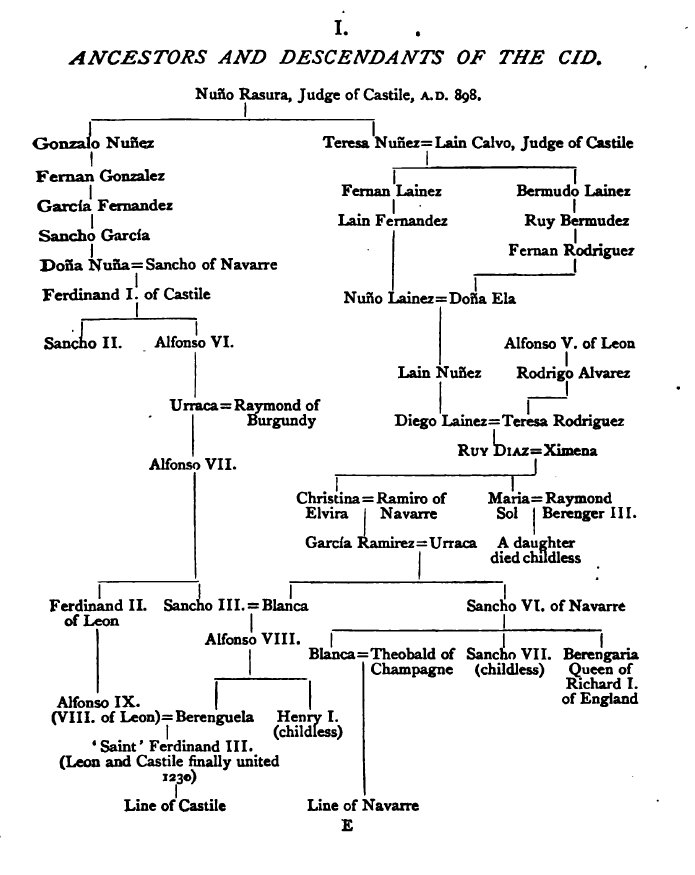
1239-1240 Barons Crusade
- Cornwall
The Barons' Crusade,
also called the Crusade of 1239, was in territorial terms the most
successful crusade since the
First. Called by Pope Gregory IX, the Barons' Crusade broadly spanned from
1234-1241 and embodied the highest point of papal endeavor "to make crusading a
universal Christian undertaking."[
This crusade to the Holy Land is sometimes discussed as two separate crusades: that of King Theobald I of Navarre, which began in 1239; and, the separate host of crusaders under the leadership of Richard of Cornwall, which arrived after Theobald departed in 1240. Additionally, the Barons' Crusade is often described in tandem with Baldwin of Courtenay's concurrent trip to Constantinople and capture of Tzurulum with a separate, smaller force of crusaders
...
Theobald of Champagne, the king of Navarre, gathered an impressive list of European nobles at Lyon, including: Hugh IV, Duke of Burgundy; Amaury VI of Montfort; Robert de Courtenay the Grand Butler of France (not to be confused with Robert I, Latin Emperor, also from Courtenay); and Peter I, Duke of Brittany. They were accompanied by a number of counts of secondary rank, including: Guigues IV of Forez, Henry II, Count of Bar, Louis of Sancerre, Jehan de Braine the Count of Mâcon, William of Joigny, and Henry of Grandpré.[9] Theobald's main force numbered some 1,500 knights, including a few hundred from Navarre.[10] They departed France in August 1239, with most sailing from Marseilles and a smaller number departing from Frederick II's ports in southern Italy. Theobald reached Acre on 1 September; he was soon joined by those crusaders who were scattered by a Mediterranean storm in transit. There they met by a council of local Christian potentates, most prominently: Walter of Brienne, Odo of Montbéliard, Balian of Beirut, John of Arsuf, and Balian of Sidon.[11] Theobald was also joined by some crusaders from Cyprus
...
On 10 June 1240
Richard, 1st Earl of Cornwall left England with a smaller host of crusaders.
This group consisted of roughly a dozen English barons and several hundred
knights, including
William II Longespée. They made their way to Marseilles in mid-September,
and landed at Acre
during the autumn passage on 8 October.
Simon de Montfort, younger brother of the captured
Amaury, was also part of this group but seems to have traveled separately.[21]
He and his wife Eleanor went to Brindisi through Apulia and Lombardy all the way
to Acre. Eleanor accompanied her husband only to Brindisi. Following that,
William of Forz organized the third successful expedition to Jerusalem. In the
end, the response of English barons to Gregory's call revealed a lack of
indication of a common Christian identity
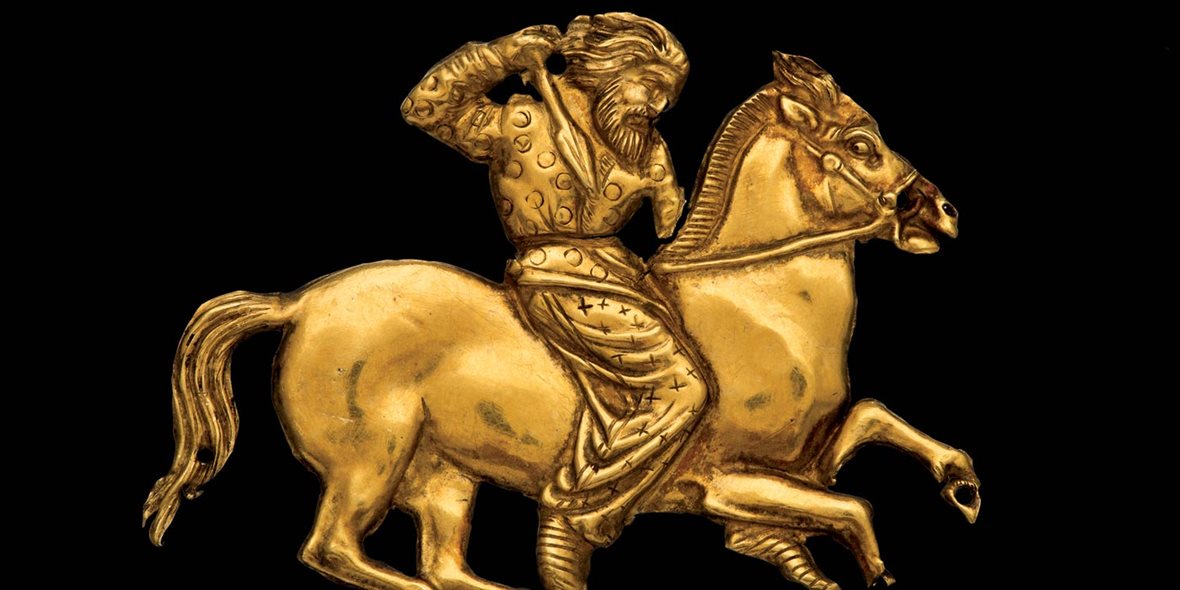
http://www.newsweek.com/ancient-icy-tomb-scythian-prince-oldest-hidden-treasures-779510
Ancient, Icy Tomb of Scythian Prince, Oldest of Its Kind, Expected to
Hold Hidden Treasures
By Kastalia Medrano On 1/12/18 at 10:02 AM
Archaeologists working in Siberia have discovered an undisturbed ancient
kurgan—a tomb of a Scythian prince. The tomb appears to be both
the oldest and largest of its kind ever recorded in southern Siberia, according
to a press release from the Swiss National Science Foundation.
...
The ancient Scythians were a nomadic people who date back to the ninth
century B.C. Caspari,
https://www.archaeology.org/images/JA2016/Scythians/Scythian-Sengileevskoe-Gold-Pectoral.jpg
Roman Beniaminson/Art Resource NY)
The solid gold Tolstaya Mogila
pectoral was uncovered at a Scythian burial site about 300 miles from
Sengileevskoe-2. Much of its workmanship and imagery, which illustrates daily
life, nature, and mythology, resembles the decoration of the Sengileevskoe-2
vessels, suggesting that they may have been created by the same goldsmiths.
The Scythians were R1a :
https://en.wikipedia.org/wiki/Haplogroup_R1a
https://upload.wikimedia.org/wikipedia/commons/7/75/Distribution_Haplogroup_R1a_Y-DNA.svg
https://dnaconsultants.com/scythian-gene/
https://en.wikipedia.org/wiki/Scythians
In artworks, the Scythians
are portrayed exhibiting European traits.[117] In Histories, the
5th-century Greek historian Herodotus describes the Budini of Scythia as
red-haired and grey-eyed
https://en.wikipedia.org/wiki/Budini
Herodotus describes the Budini people, east of the Ister (Danube) River, thusly:
[4.108] The Budini are a large and powerful nation: They all have deep
blue eyes, and bright red hair.
https://en.wikipedia.org/wiki/Scythians
...
Ancient Y-DNA data was
finally provided by Keyser et al in 2009. They studied the haplotypes
and haplogroups of 26 ancient human specimens from the Krasnoyarsk area in
Siberia dated from between the middle of the 2nd millennium BC and the 4th
century AD (Scythian and Sarmatian timeframe).
Nearly all subjects belong to
haplogroup R-M17
...
... populations known variously as Scythians,
Andronovians, etc. were blue- (or green-) eyed, fair-skinned and light-haired
people who might have played a role in the early development of the Tarim Basin
civilisation. Moreover, this study found that they were genetically
more closely related to modern populations of eastern Europe than those of
central and southern Asia.[134] The ubiquity and utter dominance of R1a Y-DNA
lineage contrasts markedly with the diversity seen in the mtDNA profiles.
...
The Scythians also feature in some national origin-legends of the Celts. In the
second paragraph of the 1320 Declaration of Arbroath, the élite of Scotland
claim Scythia as a former homeland of the Scots.
...
... other Irish
folklore, the Irish originated in Scythia and were descendants of Fénius
Farsaid, a Scythian prince who created the Ogham alphabet and who was one of the
principal architects of the Gaelic language.
...
Based on such accounts of
Scythian founders of certain Germanic as well as Celtic tribes, British
historiography in the British Empire period such as Sharon Turner in his History
of the Anglo-Saxons, made them the ancestors of the Anglo-Saxons.
...
The idea was taken up in the British Israelism of John Wilson, who
adopted and promoted the idea that the "European Race, in particular the
Anglo-Saxons, were descended from certain Scythian tribes, and these Scythian
tribes (as many had previously stated from the Middle Ages onward) were in turn
descended from the Ten Lost Tribes of Israel
earlier:
https://www.archaeology.org/issues/220-1607/features/4560-rites-of-the-scythians
Spectacular new discoveries from the Caucasus set the stage for a
dramatic hilltop ritual
By ANDREW CURRY Monday, June 13, 2016
One of two 2,400-year-old gold vessels found under a mound at the site
of Sengileevskoe-2 in southern Russia depicts griffins attacking a stag.
... In fact, some scholars think the site may have been the location of an
intense ritual and subsequent burial rite performed by some of the ancient
world’s most fearsome warriors.
From about 900 to 100 B.C.,
nomadic tribes dominated the steppes and grasslands of Eurasia, from what is
today western China all the way east to the Danube. All across this
vast expanse, archaeological evidence shows that people shared core cultural
practices. “They were all nomads, they were heavily socially stratified, they
had monumental burial structures and rich grave goods,” says Hermann Parzinger,
head of Berlin’s Prussian Cultural Heritage Foundation and former head of the
German Archaeological Institute. Today, archaeologists refer to the members of
this interconnected world as Scythians, a name used by the Greek historian
Herodotus
.
https://www.archaeology.org/images/JA2016/Scythians/Scythian-Sengileevskoe-Gold-Bowl-Combat.jpg
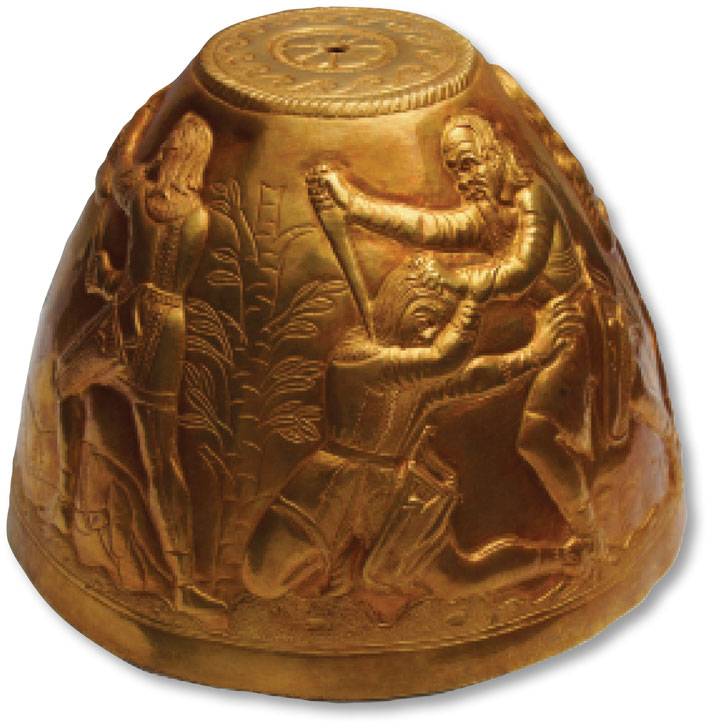
Igor Kozhevnikov/Courtesy Andrey Beliniski) The second, bowl-shaped,
Sengileevskoe-2 vessel depicts violent instances of combat, including one
showing an old man stabbing a younger warrior in the neck. In this world, the
trees thrive.
https://www.archaeology.org/images/JA2016/Scythians/Scythian-Sengileevskoe-Gold-Pectoral.jpg
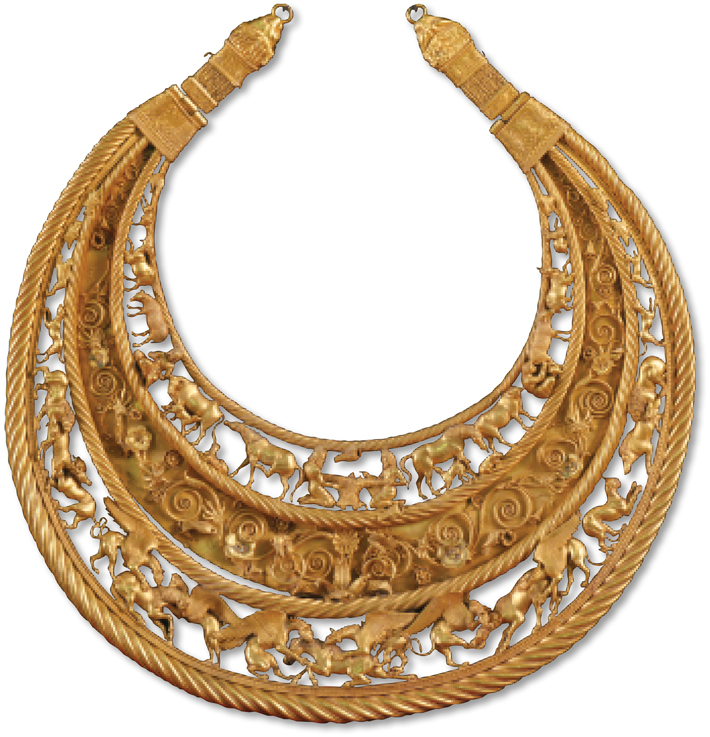
The solid gold Tolstaya Mogila pectoral was uncovered at a Scythian burial
site about 300 miles from Sengileevskoe-2. Much of its workmanship and imagery,
which illustrates daily life, nature, and mythology, resembles the decoration of
the Sengileevskoe-2 vessels, suggesting that they may have been created by the
same goldsmiths.
http://www.ancient-origins.net/news-history-archaeology/archaeologists-unearth-remains-scythian-warrior-golden-cloak-and-his-horse-020503
28 August, 2015 - 04:10
Robin Whitlock
Archaeologists unearth
remains of Scythian warrior in golden cloak and his horse ...
The
tombs occupant is thought to have been a Scythian king. ...
The Scythians
were nomads whose kingdom stretched from Iran to China and extending westwards
into what is now Eastern Europe. ...
The Royal Scyths eventually
intermarried with the Greeks and was eventually destroyed in the 2 nd century
BC. ...
The Scythians were also known for their
drug-fuelled rituals , also mentioned by Herodotus. In the summer of 2013
archaeologists discovered gold bucket-sized vessels in a kurgan which contained
traces of a black residue. When this was analysed it was found to be cannabis
and opium. The opium was probably drunk while the cannabis burnt nearby,
releasing its fumes into the air.
The discovery follows that of
another Scythian earlier this month, on this occasion involving the last resting
place of a ‘warrior woman’ . Her tomb contained over 100 arrowheads, a horse
harness, a collection of knives and a sword. In the Scythian warrior societies,
women fought alongside the men, thereby giving rise to legends about the
Amazons.
When I started the y-dna research I thought I might find connections
to other Norman or Angle familys --- still looking ...
http://originhunters.com/content/MRMPolyg.pdf
Chromosome Signature of Polygyny in Norman England
Michael R. Maglio
A thirty seven marker short tandem repeat (STR) genetic analysis of Y
chromosomes reveals an unnoted modal haplotype showing a significant association
with surnames claimed to have descended from the Norman dynasties and allied
with William, Duke of Normandy, During his conquest of England. This suggests
that such phylogenetic prevalence is a biological record, supports the
reliability of early genealogies and illustrates the link between power and
polygyny in European society.
...
Haplogroup I1, while showing
relationships across eight surnames, did not form a coherent median-joining
cluster (fig. 1).
The time to most recent common ancestor (TMRCA) on the
unique haplotypes within this group (n = 29) is estimated to be 1,250
years
ago, predating Rollo.
...
To determine a haplotype, a survey of an
extended
Norman population of allied surnames was completed
(Graf 2010,
Sykes 2000) . Surname selection was based on William’s companions during the
Battle of Hastings, many who were his kinsmen
,
Norman allies who were
rewarded with English land and surnames that were the result of polygyny.
| - - - - - - - - -
| - - - - -
The Normans went about marrying the widows of Hastings
http://scribbling-inthemargins.blogspot.com/2013/09/the-anglo-saxon-heiress-and-norman.html
The Anglo-Saxon Heiress and The Norman Conquest Anglo-Saxon women
played an important role in the years following The Conquest by providing the
opportunity for intermarriage into the landowning class of Saxon society.
This intermarriage gave legitimacy that cloaks the conquerors
with respectability. Oderic Vitalis writing in the early 1130s speaks of rich
English magnates who were Normans already settled in England before 1066 and
also those who were Normans from mixed parentage and raised in England. Normans
and French men who settled in England before 1066 were regarded as Anglici
suggesting that to an extent integration had begun before Conquest.
...
An obvious way to secure land was to marry an heiress. The Breton Geoffery de la
Guerche apparently acquired the lands of Leofine, Harold's brother who died at
Hastings through marriage with Leofwine's daughter Aelfgifu.
Sometimes
the enforced marriage policy was not welcome and the ladies took refuge in
nunneries 'not for love of religious life but from fear of the French',
according to Oderic Vitalis.
William also had been concerned to restore
land to the English nobility who accepted Norman rule. Just after Hastings
penances due from William's men for destruction were lessened if they married
into the enemy. And this penance for Norman knights could be costly.
| -
- - - -
This was a time of the
defeated . High born Anglo-Saxon widows with powerful connections were given
their due ... Others, Normans would show up run off the remaining sons and say
all this is mine now ... Lets make it legal ...
"Sometimes the enforced marriage policy was not welcome and the ladies took
refuge in nunneries 'not for love of religious life but from fear of the
French', according to Oderic Vitalis."
see also: http://www.hsu.edu/academicforum/2001-2002/2001-2AFDAUGHTERS.pdf
DAUGHTERS, WIVES, AND WIDOWS: A STUDY OF ANGLO-SAXON AND
ANGLO-NORMAN NOBLE WOMEN
Abstract
Traditional medieval
histories have tended to downplay the role of noble women in early medieval
England. However, increasingly popular gender studies in the last twenty years
have prompted a renewed interest by scholars eager to make up for lost time and
assign women a more significant role.
...
Historians now
conclude that, to the contrary, Anglo-Saxon noble women were relatively
independent through their land-holding rights while, by contrast, later
Anglo-Norman noble women lost some independence when land ownership became
closely associated with the new military-based society that followed the Norman
Conquest in 1066.
| - - - - - -
Lets see ... I have a old wife in Normandy
and now I have a new "wife" in Kent ... and another reason these men had
multiple nom de plume's It also seems to be clash of cultures between older
Viking / warlord pagan culture and the new Christian orthodox one
...
http://www.history.ac.uk/reviews/review/1459
Bigamy and
Christian Identity in Late Medieval Champagne Sara McDougall
...
McDougall also provides us with some demographic information about
people who committed bigamy. They were usually mature or older persons who had
spent some years in their previous marriage.
The men tended to
remarry in a different locale than where they had resided with their first
spouse.
Both men and women claimed that they were widowers and
widows respectively, either out of genuine belief or in order to dissemble about
their true status. Concerning why people would risk punishment to remarry,
McDougall covers the usual litany of explanations (e.g. economic stability,
seeking a more fulfilling relationship, to leave a spouse who committed
adultery, etc.) (pp. 101–2). But she also helpfully adds to it. She notes that
while having children per se was not a motivating factor as far as the
records indicate, the guarantee of legitimacy to any child born of a bigamous
union may well have been (p. 105). Perhaps even more importantly,
through their partially fabricated tales along with publically solemnizing their
new marriages, these bigamists, according to McDougall, were seeking a
‘Christian monogamous marriage’ (p. 100).
https://en.wikipedia.org/wiki/Polygamy_in_Christianity
...
In the medieval period, multiple wives were often obtained through
kidnapping. It is with this in view that we must interpret the
following laws: The Frankish Laws of 818–9 strictly forbade kidnapping of
women.[33] The XXVII. law issued by King Stephen I of Hungary (1000–1030)
declares that the kidnapper must return the woman to her parents even if he has
had sexual intercourse with her, and must pay a penalty to the parents.
According to the Hungarian law, the kidnapped girl was then free to marry
whomever.[33]
Outlaws in Austrailia ...
https://s3-ap-southeast-2.amazonaws.com/awm-media/collection/PAFU2013/118.01/video/6022329.MP4
https://www.awm.gov.au/collection/PAFU2013/118.01/
The Last
Post Ceremony commemorating the service of (3367) Private William Samuel Outlaw,
53rd Battalion (Infantry), First World War
Accession Number
PAFU2013/118.01
Collection type Film
Object type Last Post film
Physical description 16:9
Maker Australian War Memorial
Place made
Australia: Australian Capital Territory, Canberra, Campbell
Date made 7
November 2013
Access Open
Conflict First World War, 1914-1918
Copyright Item copyright: ? Australian War Memorial
Creative Commons
License This item is licensed under CC BY-NC
Copying Provisions Copy
provided for personal non-commercial use
Description
The Last Post
Ceremony is presented in the Commemorative area of the Australian War Memorial
each day.
The ceremony commemorates more than 102,000
Australians who have given their lives in war and other operations and whose
names are recorded on the Roll of Honour.
At each ceremony the
story behind one of the names on the Roll of Honour is told. Hosted by Troy
Clayton, the story for this day was on (3367) Private William Samuel
Outlaw, 53rd Battalion (Infantry), First World War.
Speech
transcript
3367 Private William Samuel Outlaw, 53rd Battalion
KIA 19 July 1916
No photograph in collection
Story delivered
7 November 2013
Today we remember and pay tribute to Private
William Samuel Outlaw.
William Outlaw was born in
Newtown, Sydney, the son of William and Blanche Outlaw. He attended
Canterbury Public School and then began work as a carter for a grocery in the
same district. He was also well acquainted with military service, having spent
one year as a senior cadet and three years with the militia forces as a
signaller. He enlisted in the Australian Imperial Force in August 1915 and,
after a period of training in Australia, was sent overseas with the 11th
reinforcements to the 2nd Battalion.
Outlaw arrived in Egypt at a time
when the AIF was undergoing a period of reorganisation and training following
the evacuation of Gallipoli. As a part of this process, he was transferred to
the 53rd Battalion and sent to France.
On 19 July the 53rd Battalion took
part in their first major operation on the Western Front - the ill-fated
attack on the French village of Fromelles. When the battle was over, the
Australian 5th Division, of which the 53rd Battalion was a part, had suffered
5,533 casualties and could not fight again for many months. Even
assessing the number of casualties took months, as many men were initially
reported wounded or missing, and it was not known if they had been killed or
were taken prisoner.
One of those men was Private William Outlaw. He was
originally reported wounded and missing, having last been seen very badly hit
and lying in the German trenches. He never appeared on the lists of prisoners
coming from Germany, and it was eventually determined that he had been killed in
action. He was 23.
William's father died in 1922, but his mother,
sisters, and brother regularly put notices in the Sydney Morning Herald for many
years to commemorate their son and brother who "shouldered his gun in honour's
cause".
His name is listed on the Roll of Honour on my right, along with
more than 60,000 others from the First World War.
This is but one of the
many stories of courage and sacrifice told here at the Australian War
Memorial. We now remember Private William Samuel Outlaw, and
all of those Australians who have given their lives in the service of our
nation.
---- >>> Back to Outlawe Research Journal - Page 13